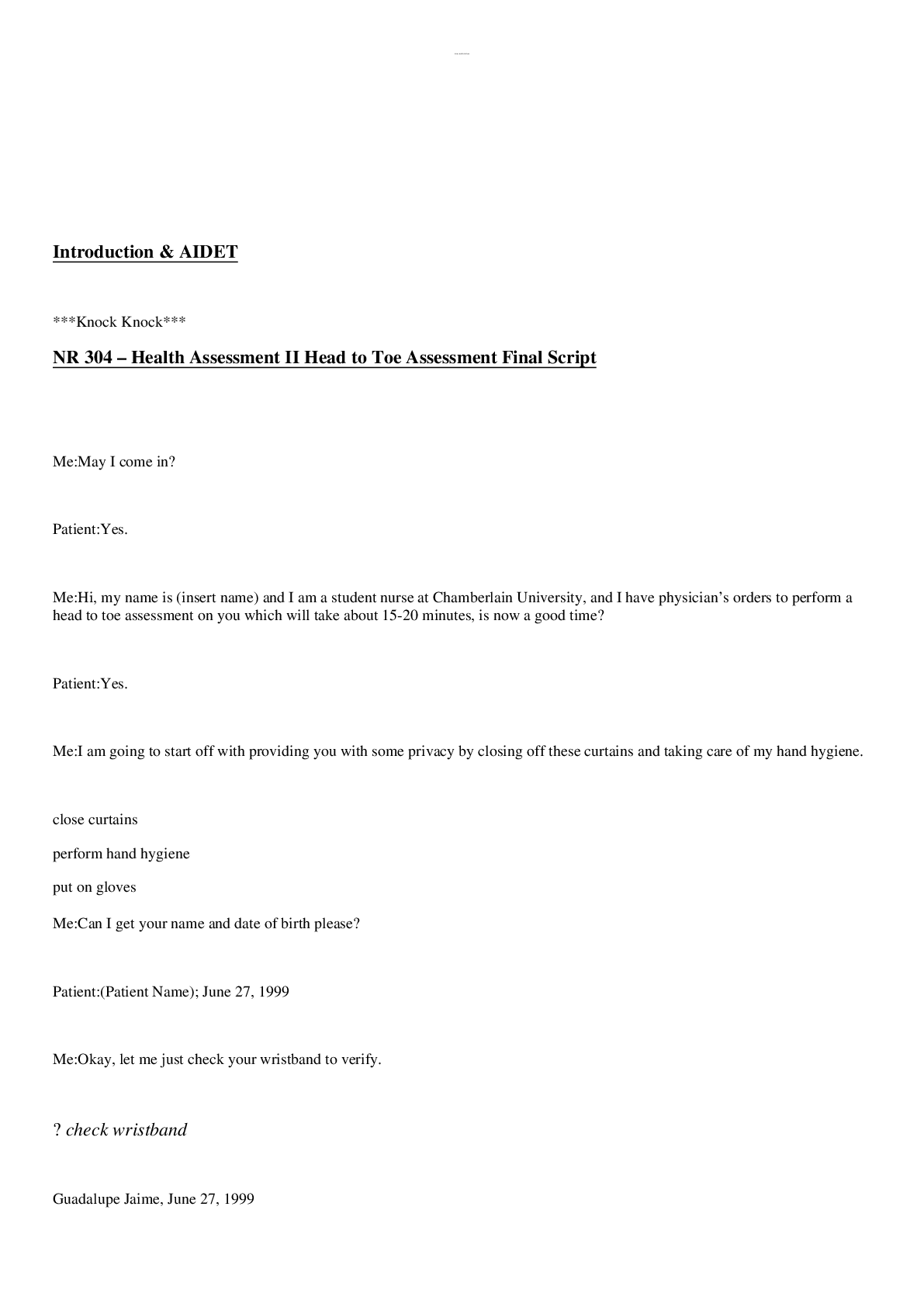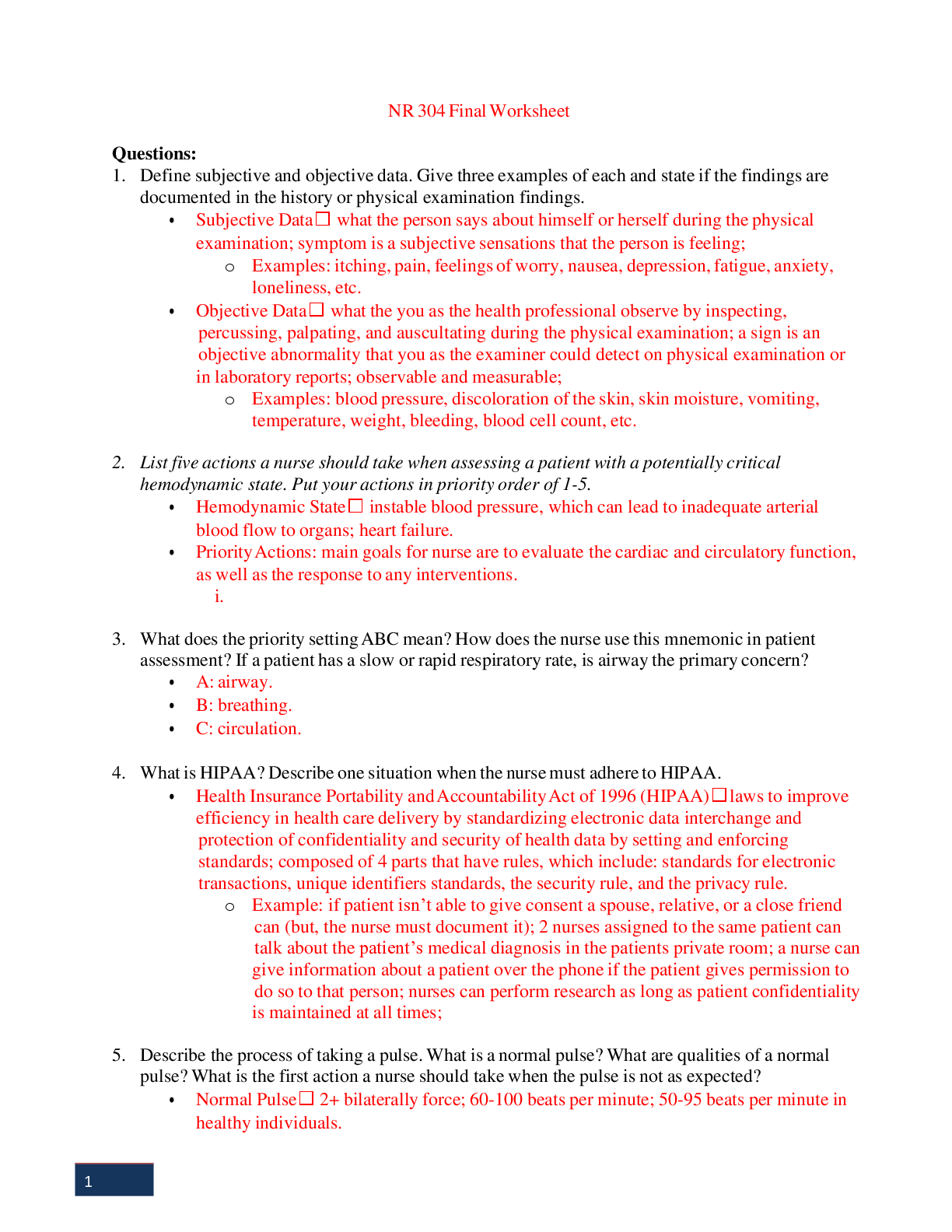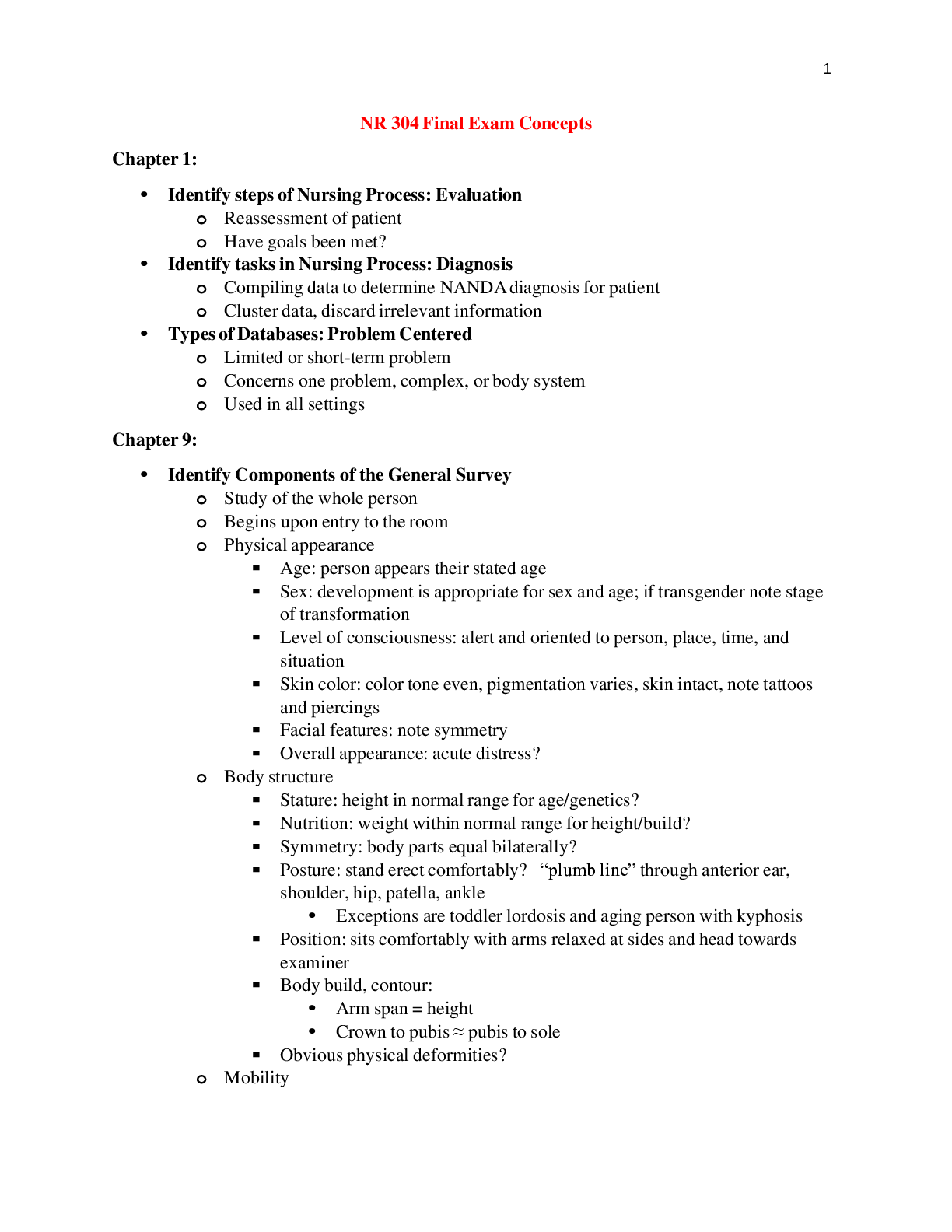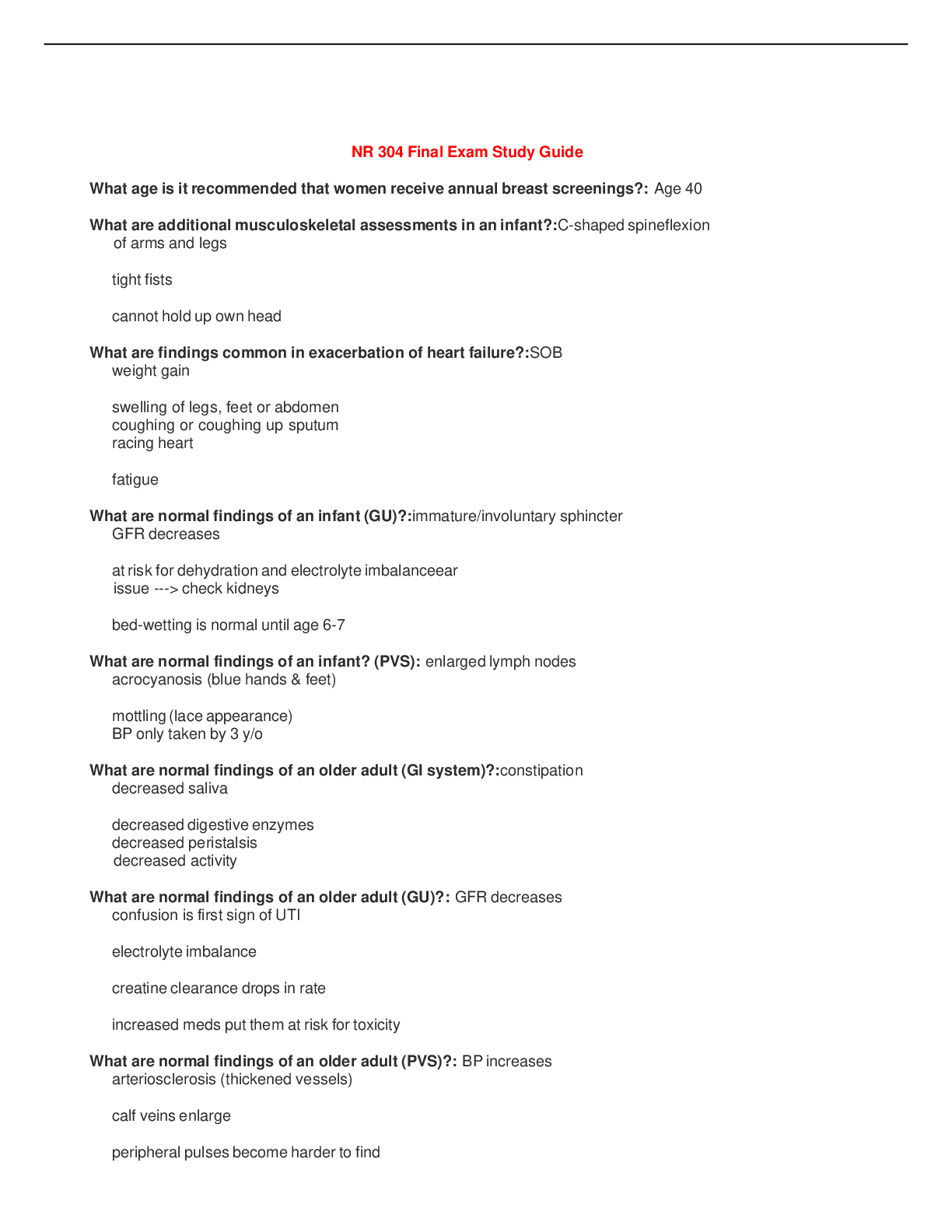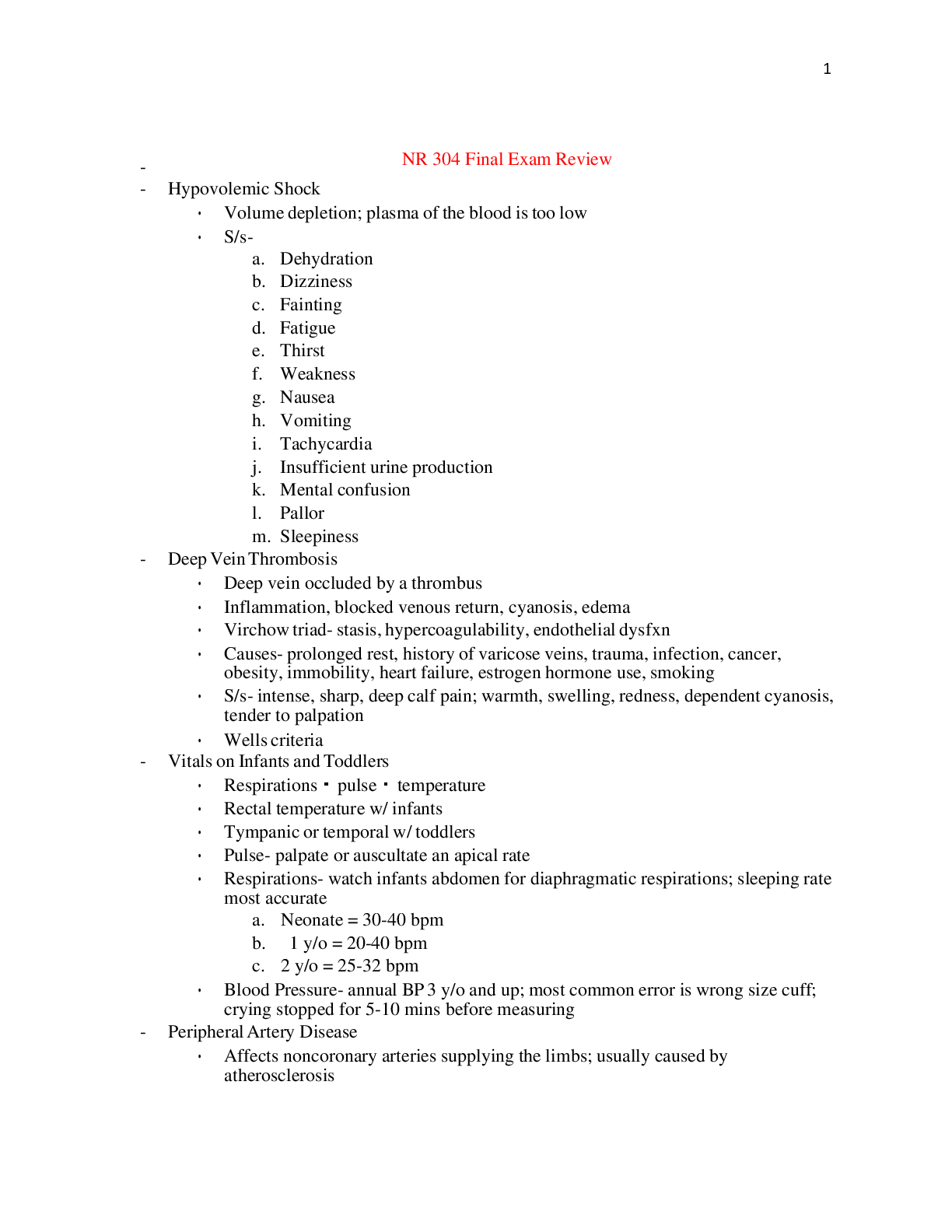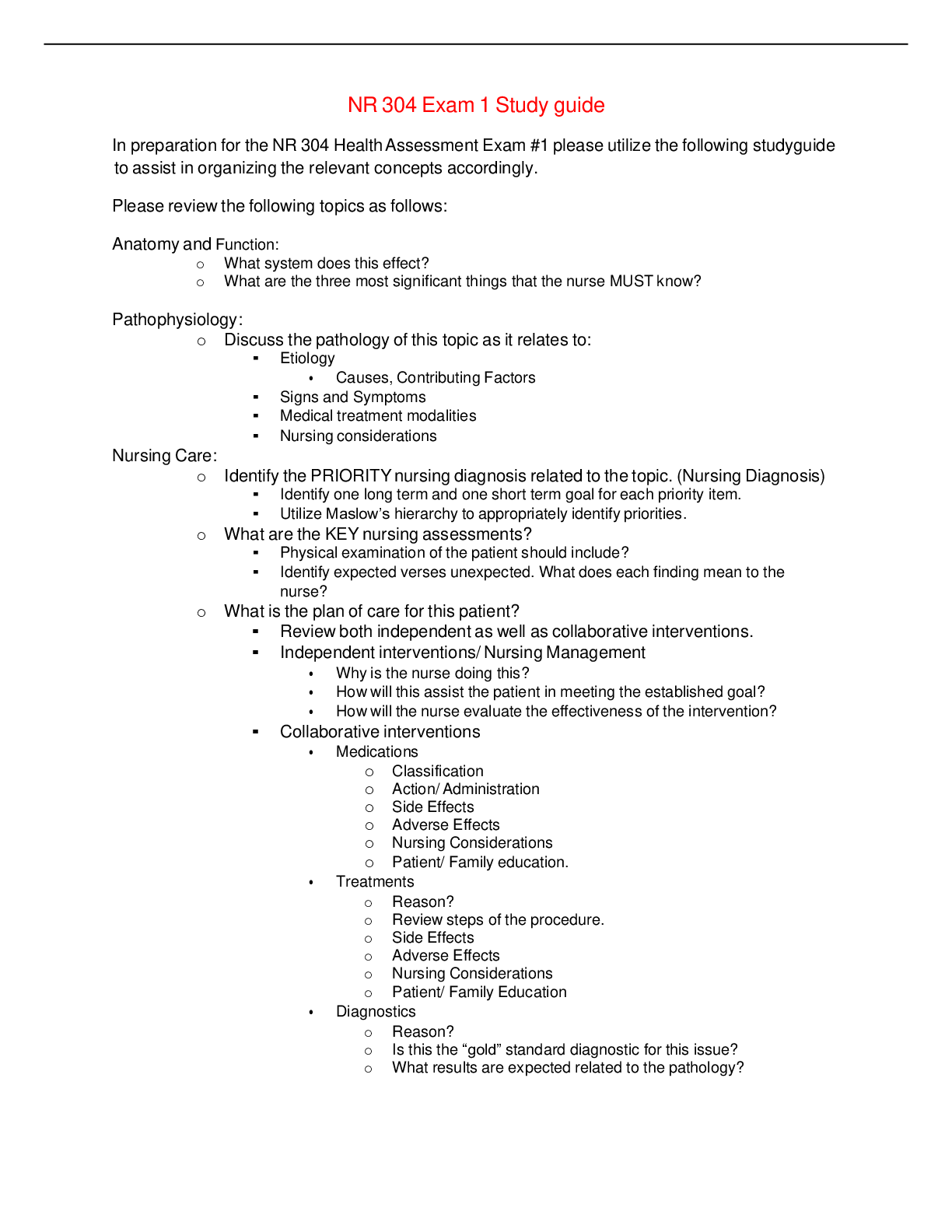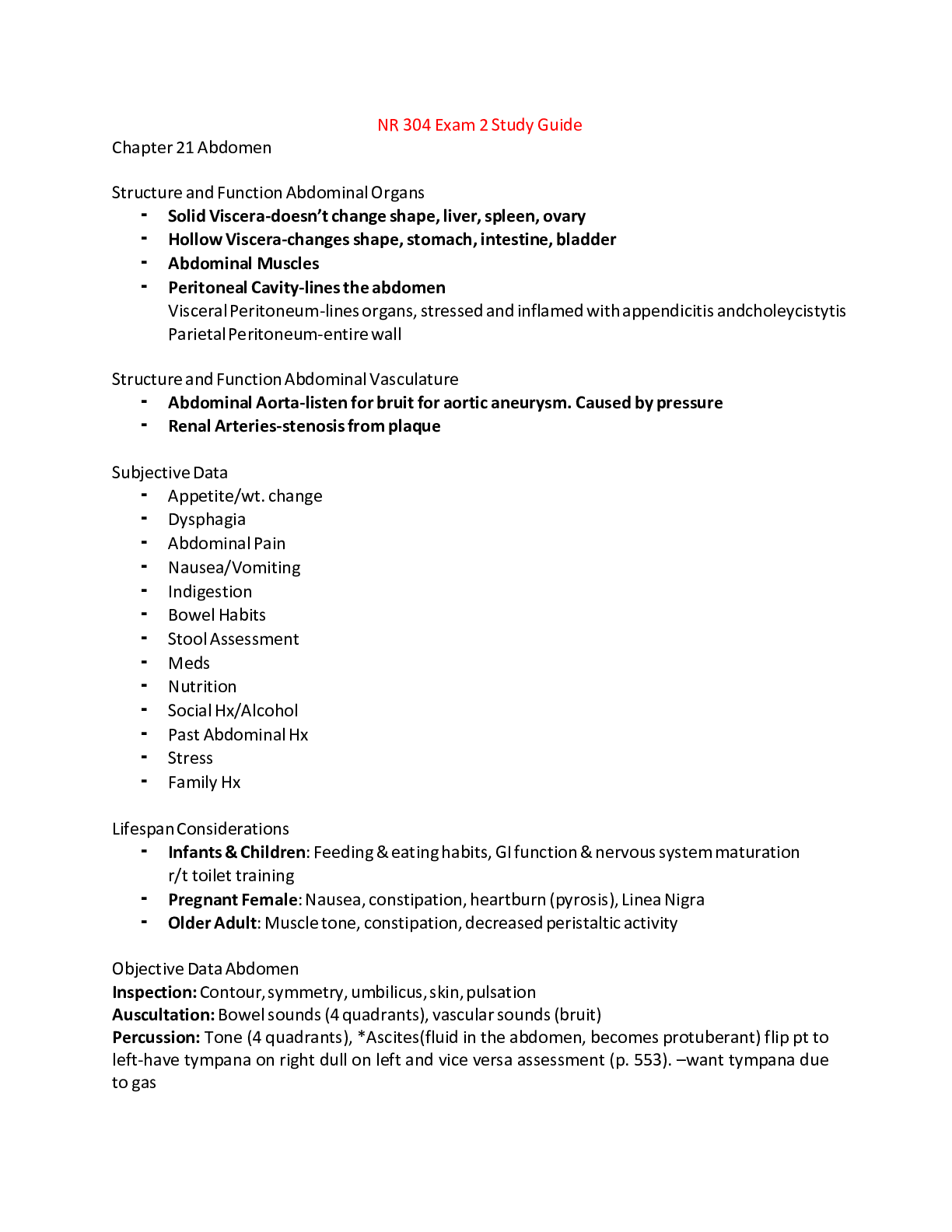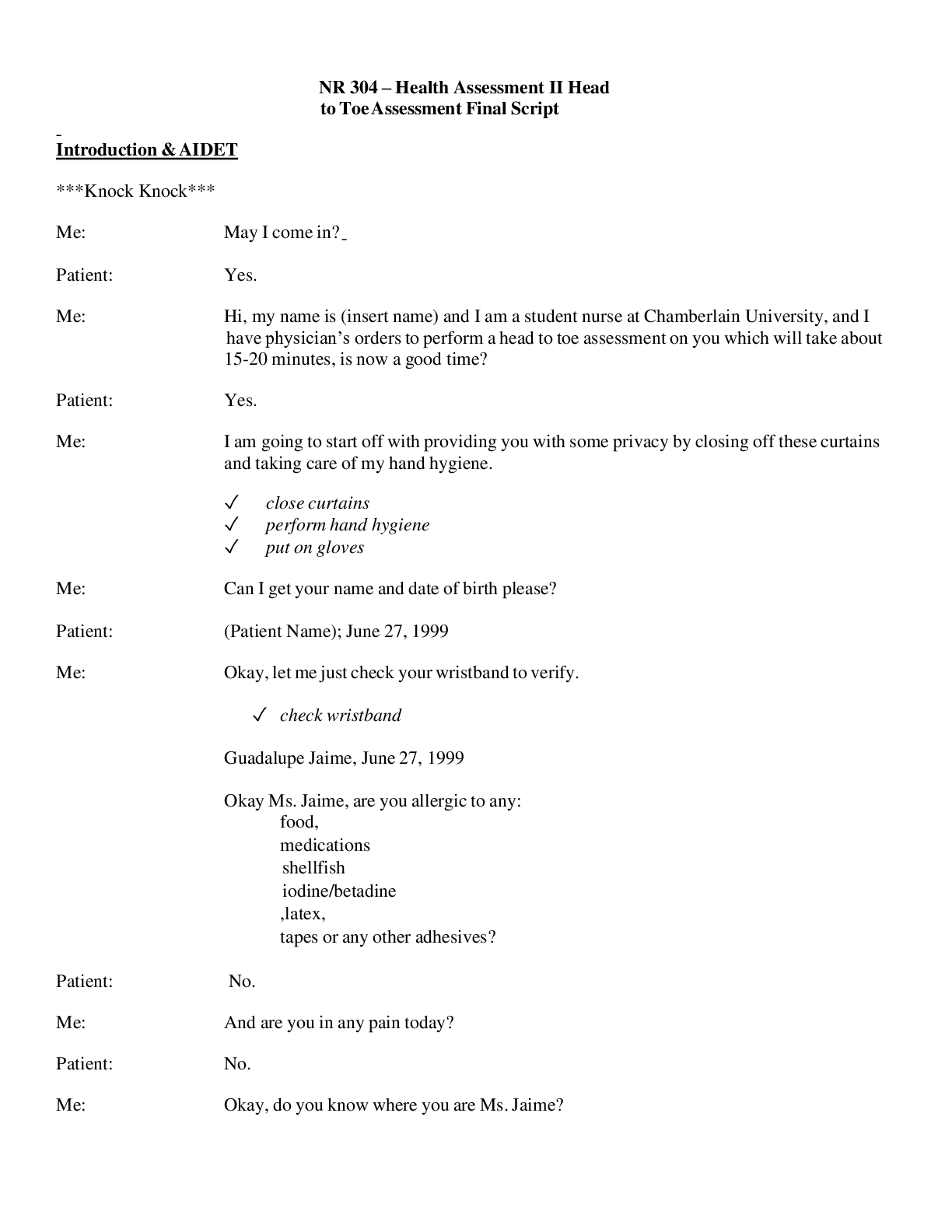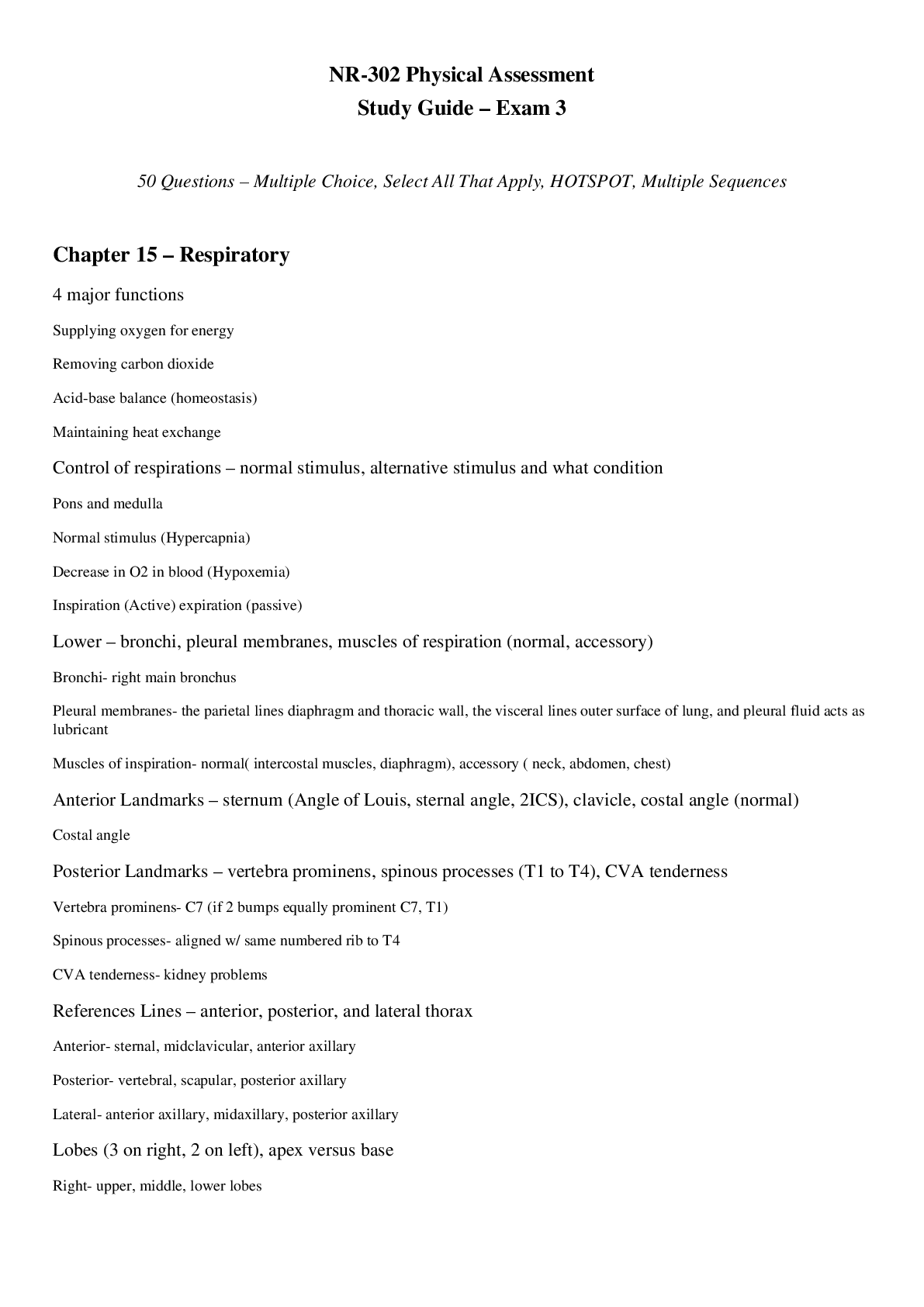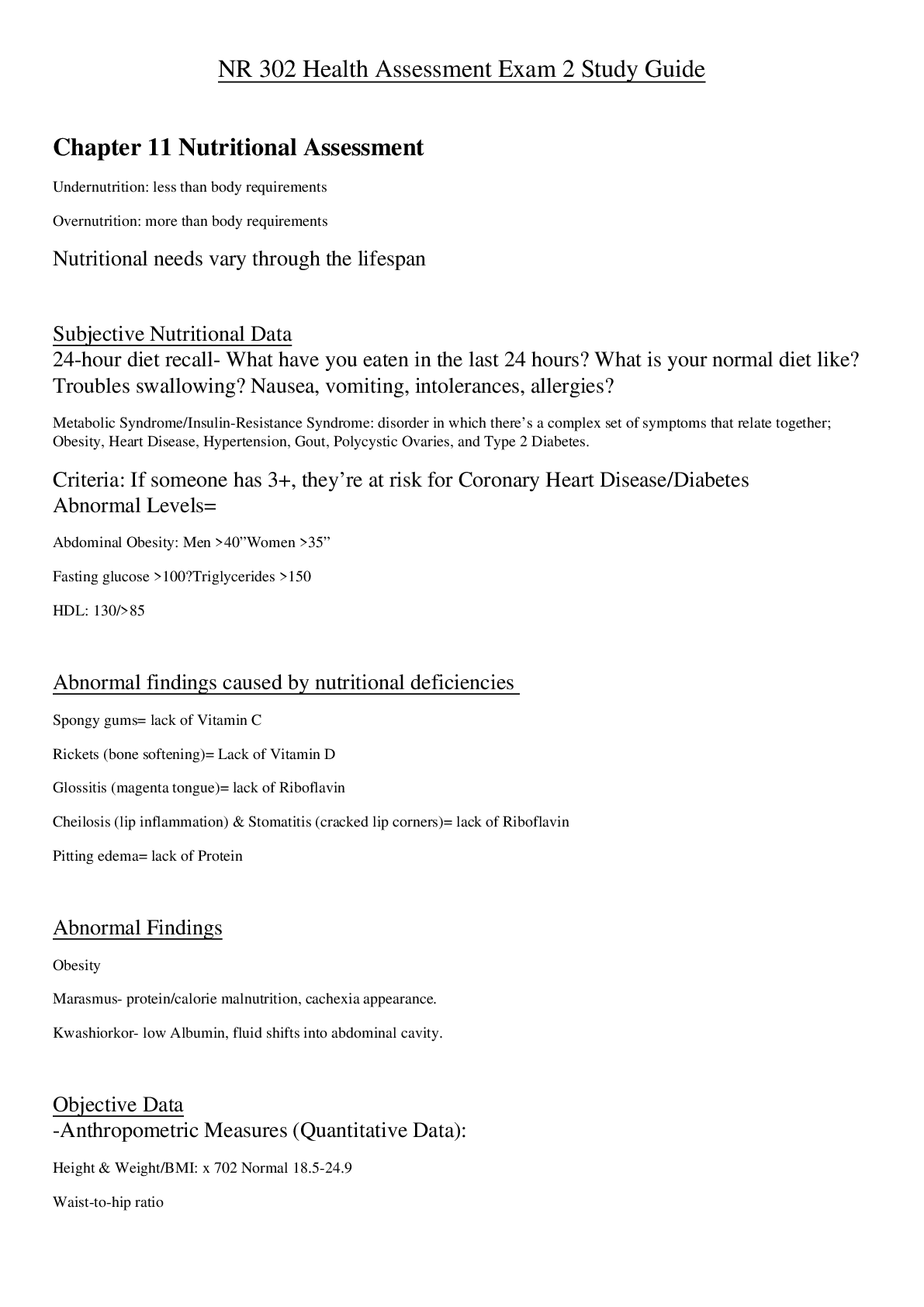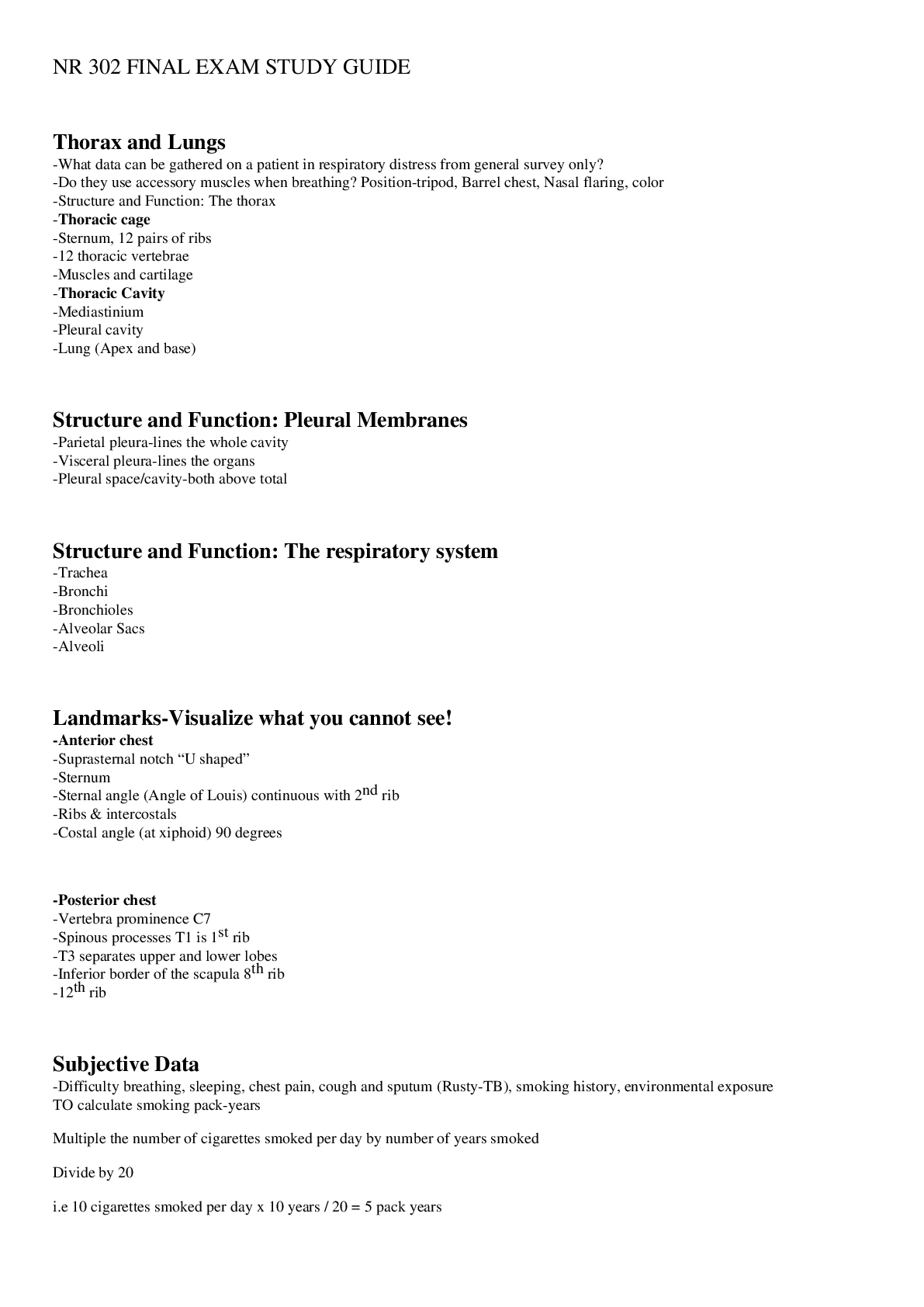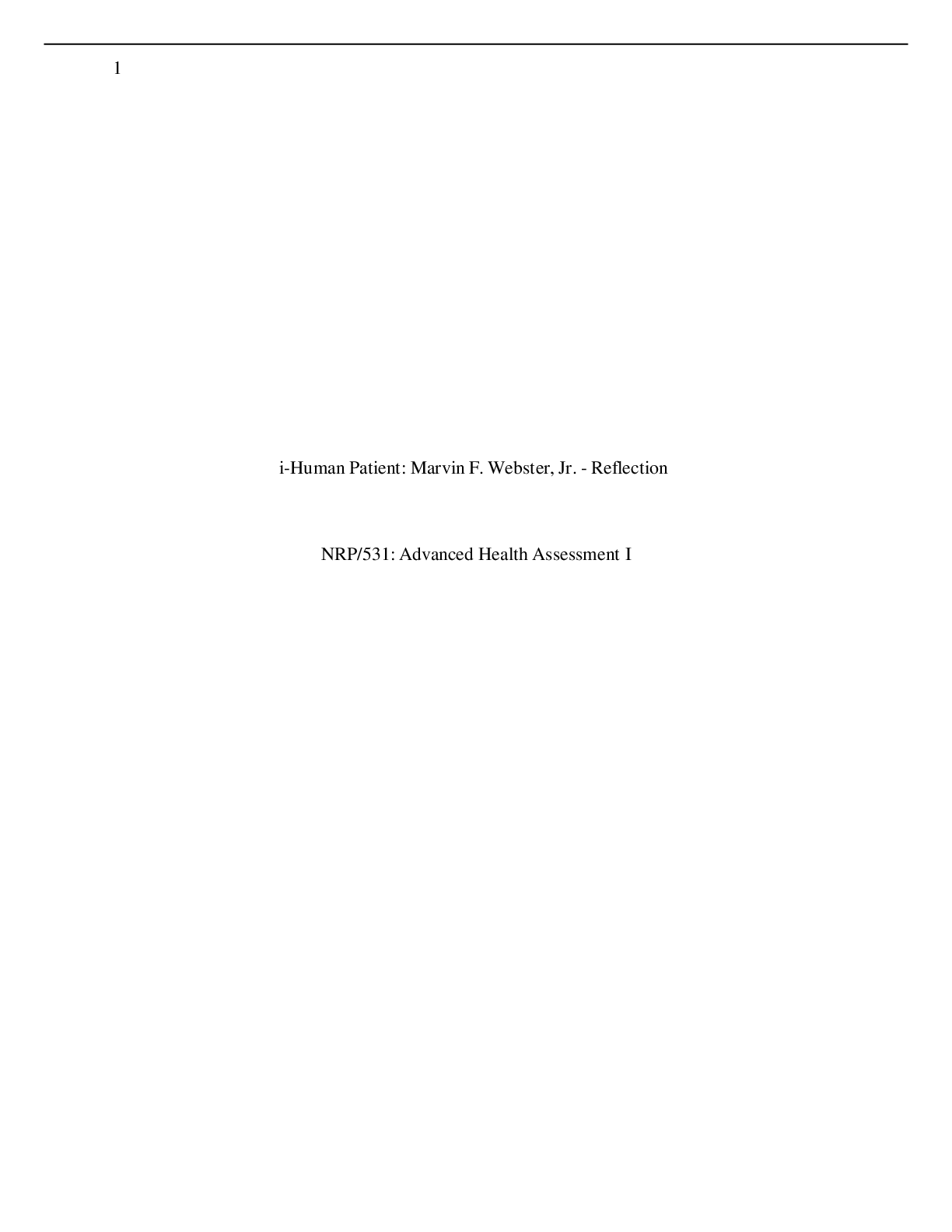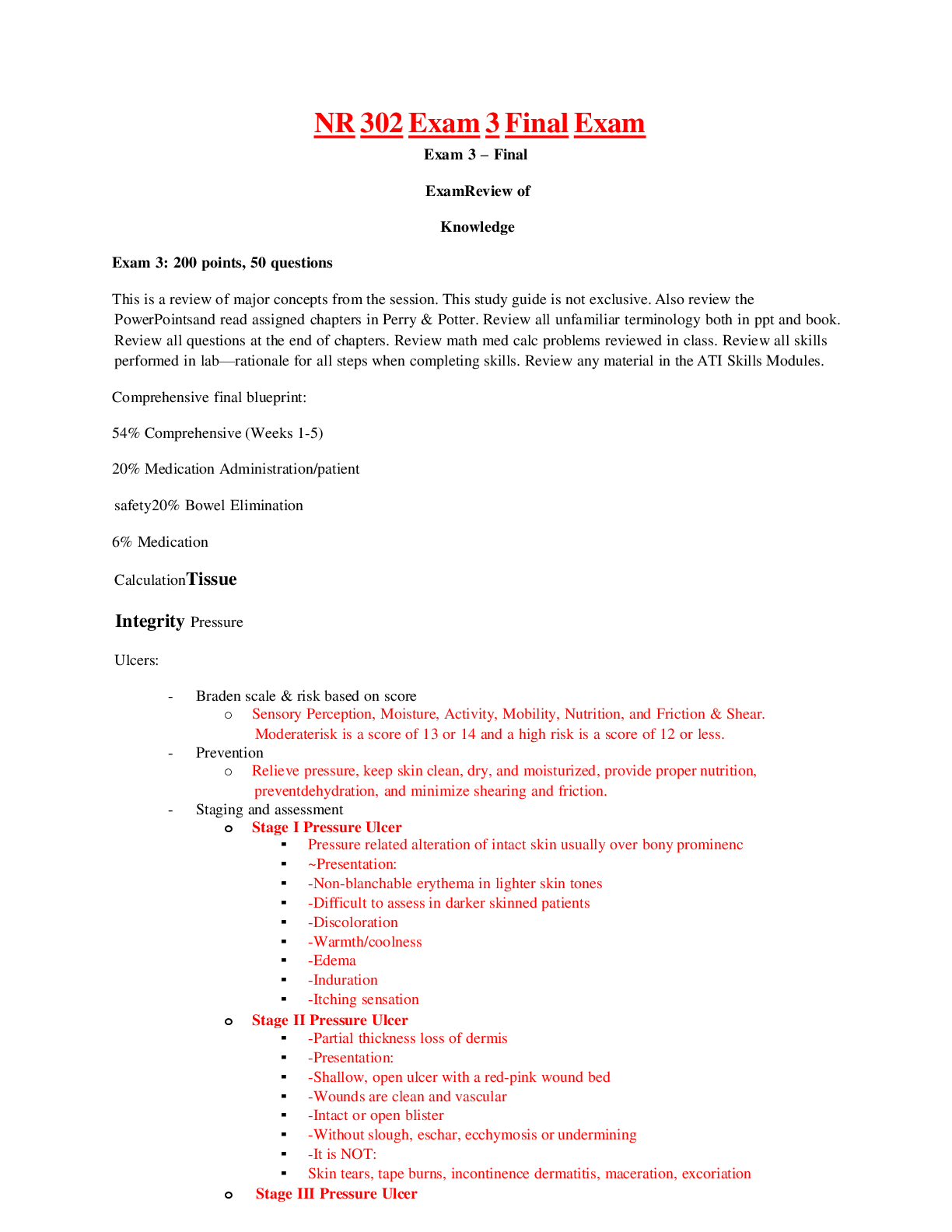*NURSING > STUDY GUIDE > NR 302 Health Assessment I Unit 4 Pre-test (All)
NR 302 Health Assessment I Unit 4 Pre-test
Document Content and Description Below
NR302 Health Assessment I 1 NR 302 Health Assessment I Unit 4 Pre-test Answer the following questions. Give rationales for each question asked. Upload test questions and rationales to the submissi... on tab under the course shell. Questions will be graded for accuracy. Each question along with the rationale will be worth 1 point, for a total of 15 points possible. Late policy applies. Chapter 14 1. During ocular examinations, the nurse keeps in mind that movement of the extraocular muscles is: a. Decreased in the older adult. b. Impaired in a patient with cataracts. c. Stimulated by cranial nerves (CNs) I and II. d. Stimulated by CNs III, IV, and VI. Rationale: In our textbook on page 277, it states that the extraocular muscles are controlled by cranial nerve III, IV, and VI. Each of these ocular muscles is coordinated with one in the other eye making the muscles in the eye move together, which is called conjugate movement (pg. 277). 2. The nurse is testing a patient’s visual accommodation, which refers to which action? a. Pupillary constriction when looking at a near object b. Pupillary dilation when looking at a far object c. Changes in peripheral vision in response to light d. Involuntary blinking in the presence of bright light Rationale: As stated in our book on page 277, accommodation is the adaptation of the eye for near vision. It is talented by increasing the curvature of the lens through the muscle of the ciliary body. The eye lens cannot be observed directly, the components of accommodation that can be observed are convergence, which means motion toward, of the axes of the eyeballs and pupillary constriction (pg. 277). 3. Which of these assessment findings would the nurse expect to see when examining the eyes of a black patient? a. Increased night vision b. Dark retinal background c. Increased photosensitivity d. Narrowed palpebral fissures Rationale:NR302 Health Assessment I 2 Reading this chapter, I learned that the retinal background in any patient will be a slightly darker color and it will be where the sharpest vision in the patient is apparent. The structures that make up the retinal background are the macula, fovea centralis and retinal vessels. To be specific the macula is what has a darker pigmentation because it is on the temporal side of the fundus (pg. 278). 4. A 52-year-old patient describes the presence of occasional floaters or spots moving in front of his eyes. The nurse should: a. Examine the retina to determine the number of floaters. b. Presume the patient has glaucoma and refer him for further testing. c. Consider these to be abnormal findings and refer him to an ophthalmologist. d. Know that floaters are usually insignificant and are caused by condensed vitreous fibers. Rationale: Our textbook describes floaters as something that is common in people over the age of 50 and can be the result of condensed vitreous fibers. Floaters can develop more intensely in those who are suffering from retinal detachment. In most cases these are considered a normal finding (pg. 280-281). 5. The nurse is preparing to assess the visual acuity of a 16-year-old patient. How should the nurse proceed? a. Perform the confrontation test. b. Ask the patient to read the print on a handheld Jaeger card. c. Use the Snellen chart positioned 20 feet away from the patient. d. Determine the patient’s ability to read newsprint at a distance of 12 to 14 inches. Rationale: Chapter 15 of our textbook says the most common used test for visual acuity is the Snellen chart. Place the patient 20 feet away, and they are to read the letters that they see on the sheet using an opaque card to block one eye. This test will help the nurse identify if the patient needs glasses or not (pg. 283). 6. A patient’s vision is recorded as 20/30 when the Snellen eye chart is used. The nurse interprets these results to indicate that: a. At 30 feet the patient can read the entire chart. b. The patient can read at 20 feet what a person with normal vision can read at 30 feet. c. The patient can read the chart from 20 feet in the left eye and 30 feet in the right eye. d. The patient can read from 30 feet what a person with normal vision can read from 20 feet. Rationale:NR302 Health Assessment I 3 As explained by our textbook on page 283, when translating the Snellen eye chart, the number on the bottom represents the distance that someone with normal vision would be able to read at and the top number represents the distance at which the patient is able to read at (pg. 283). 7. A patient is unable to read even the largest letters on the Snellen chart. The nurse should take which action next? a. Refer the patient to an ophthalmologist or optometrist for further evaluation. b. Assess whether the patient can count the nurse’s fingers when they are placed in front of his or her eyes. c. Ask the patient to put on his or her reading glasses and attempt to read the Snellen chart again. d. Shorten the distance between the patient and the chart until the letters are seen and record that distance. Rationale: If a patient cannot see even the largest letters on a Snellen eye chart, the nurse should move the chart closer to the patient or have the patient move closer to the eye chart, so they are able to observe the letters (pg. 283). 8. A 2-week-old infant can fixate on an object but cannot follow a light or bright toy. The nurse would: a. Consider this a normal finding. b. Assess the pupillary light reflex for possible blindness. c. Continue with the examination and assess visual fields. d. Expect that a 2-week-old infant should be able to fixate and follow an object. Rationale: Once an infant is exposed to light, they will refuse to open their eyes afterwards. They will also begin to fixate on objects, and these are considered normal finding. If a newborn is fixated on objects but not necessarily following a light, they are considered on the right tract for their ocular behaviors (pg. 295). 9. The nurse notices the presence of periorbital edema when performing an eye assessment on a 70-year-old patient. The nurse should: a. Check for the presence of exophthalmos. b. Suspect that the patient has hyperthyroidism. c. Ask the patient if he or she has a history of heart failure. d. Assess for blepharitis, which is often associated with periorbital edema. Rationale: As discussed in our textbook, preorbital edema is when the eyes and eyelids of a patient are swollen and the connective tissue that connects the lids are loose. This is an eyelid abnormality and is found in patients who are in congestive heart failure, renal failure, someone who may be experiencing an allergic reaction, or someone with hypothyroidism (pg. 305).NR302 Health Assessment I 4 10. During an examination, a patient states that she was diagnosed with open-angle glaucoma 2 years ago. The nurse assesses for characteristics of open-angle glaucoma. Which of these are characteristics of open-angle glaucoma? Select all that apply. a. Patient may experience sensitivity to light, nausea, and halos around lights. b. Patient experiences tunnel vision in the late stages. c. Immediate treatment is needed. d. Vision loss begins with peripheral vision. e. Open-angle glaucoma causes sudden attacks of increased pressure that cause blurred vision. f. Virtually no symptoms are exhibited. Rationale: Open-angle glaucoma can be described and an increased intraocular pressure and consequently decreases the blood supply to certain retinal structures. However, peripheral vision may begin to decrease causing “tunnel vision” in more advanced cases. In many patients, open-angle glaucoma is asymptomatic because there is no extraordinary “abnormality” in the external structures of the eyes (pg. 310). Chapter 15 1. A patient has been shown to have a sensorineural hearing loss. During the assessment, it would be important for the nurse to: a. Speak loudly so the patient can hear the questions. b. Assess for middle ear infection as a possible cause. c. Ask the patient what medications he is currently taking. d. Look for the source of the obstruction in the external ear. Rationale: As noted in this chapter, sensorineural hearing loss can be caused by presbycusis which is a gradual nerve degeneration. There are many reasons behind nerve degeneration like the patients age or certain drugs can affect the patient’s hair cells in their cochlea. It is important to ask what type of medications they are currently taking because if ototoxic drugs are noted, you can then decipher why the patient is experiencing such hearing loss (pg. 319). 2. The mother of a 2-year-old is concerned because her son has had three ear infections in the past year. What would be an appropriate response by the nurse? a. “It is unusual for a small child to have frequent ear infections unless something else is wrong.” b. “We need to check the immune system of your son to determine why he is having so many ear infections.” c. “Ear infections are not uncommon in infants and toddlers because they tend to have more cerumen in the external ear.”NR302 Health Assessment I 5 d. “Your son’s eustachian tube is shorter and wider than yours because of his age, which allows for infections to develop more easily.” Rationale: Because of a child’s size, it just makes more sense that a eustachian tubes in children are much shorter when compared to their parent or an adult. The lumen in their eustachian tube becomes occluded much quicker and easier and this they are more prone to get frequent ear infections. Another important reason to note that adults have a lesser chance of ear infections because their ear canals have more of a slope which gives less room for occlusions of the lumen. (pg. 320). 3. The nurse is taking the history of a patient who may have a perforated eardrum. What would be an important question in this situation? a. “Do you ever notice ringing or crackling in your ears?” b. “When was the last time you had your hearing checked?” c. “Have you ever been told that you have any type of hearing loss?” d. “Is there any relationship between the ear pain and the discharge you mentioned?” Rationale: As mentioned in our textbook, conductive hearing loss id hearing loss that is due to an impacted cerumen, perforated tympanic membrane, serum or pus in the middle ear and osteosclerosis of the ear. As the nurse, I would ask this question because ear pain related to a perforated ear drum can be related to other types of conductive hearing loss which could be any discharge from the ear which could be possible due to an impacted cerumen or any osteosclerosis (pg. 319). 4. The nurse is performing an otoscopic examination on an adult. Which of these actions is correct? a. Tilting the person’s head forward during the examination b. Once the speculum is in the ear, releasing the traction c. Pulling the pinna up and back before inserting the speculum d. Using the smallest speculum to decrease the amount of discomfort Rationale: As we learned in class and what I read in the textbook, when performing an otoscopic examination on an adult, it is important to pull the pinna of the ear back in order to insert the speculum into the ear and get a good visual. When pulling the pinna back it gives the nurse a good opportunity to get a clearer view of the internal structures of the ear. Additionally, you can also ask the patient to reposition their head to view down the canal (pg. 325). 5. The nurse is assessing a 16-year-old patient who has suffered head injuries from a recent motor vehicle accident. Which of these statements indicates the most important reason for assessing for any drainage from the ear canal? a. If the drum has ruptured, then purulent drainage will result.NR302 Health Assessment I 6 b. Bloody or clear watery drainage can indicate a basal skull fracture. c. The auditory canal many be occluded from increased cerumen. d. Foreign bodies from the accident may cause occlusion of the canal. Rationale: When reading into the book, I noted that the book talks about the relationship between motor vehicle accidents and drainage from the ear canal. The book says that if a patient is suffering from a head injury or skull fracture a clear bloody fluid can be observed as drainage from the ears. This type of observation will require immediate attention because the fluid is often CFS (pg. 326). 6. An assessment of a 23-year-old patient reveals the following: an auricle that is tender and reddish-blue in color with small vesicles. The nurse would need to know additional information that includes which of these? a. Any change in the ability to hear b. Any recent drainage from the ear c. Recent history of trauma to the ear d. Any prolonged exposure to extreme cold Rationale: The auricle contains the external portions of the ear. When these structures are exposed to extreme colds for long amounts of time, they can begin to feel tender and change their color slightly. This is something as the nurse we want to note because if these structures lose complete feeling or nerves begin to damage, hearing loss can this be affected (pg. 326). 7. The nurse is performing a middle ear assessment on a 15-year-old patient who has had a history of chronic ear infections. When examining the right tympanic membrane, the nurse sees the presence of dense white patches. The tympanic membrane is otherwise unremarkable. It is pearly, with the light reflex at 5 o’clock and landmarks visible. The nurse should: a. Refer the patient for the possibility of a fungal infection. b. Know that these are scars caused from frequent ear infections. c. Consider that these findings may represent the presence of blood in the middle ear. d. Be concerned about the ability to hear because of this abnormality on the tympanic membrane. Rationale: Dense white patches in the inner ear are often signs of scaring that can come from frequent infections that can cause damage to the tympanic membrane. Since we know that the patient (15-year-old) has had chronic ear infections, these white patches are simply scarring that can come from the patient’s frequent ear infections (pg. 338). 8. The nurse is conducting a child safety class for new mothers. Which factor places young children at risk for ear infections?NR302 Health Assessment I 7 a. Family history b. Air conditioning c. Excessive cerumen d. Passive cigarette smoke Rationale: Our textbook talks about the risks, signs and symptoms for certain ear abnormalities and infections. It is noted that parental and passive parental smoke can place younger children at risk for ear infections. The smoke can weaken their immune system and make the children more susceptible to build up their ears and cause infections (pg. 323). 9. A 17-year-old student is a swimmer on her high school’s swim team. She has had three bouts of otitis externa this season and wants to know what to do to prevent it. The nurse instructs her to: a. Use a cotton-tipped swab to dry the ear canals thoroughly after each swim. b. Use rubbing alcohol or 2% acetic acid eardrops after every swim. c. Irrigate the ears with warm water and a bulb syringe after each swim. d. Rinse the ears with a warmed solution of mineral oil and hydrogen peroxide. Rationale: In our textbook, it is explained that the otitis externa is often referred to as “swimmers’ ear” and it can be best prevented by using 2% rubbing alcohol after every swim. The rubbing alcohol will prevent the external structures of the ear from getting overly waterlogged and it can aid in reducing infection and inflammation of skinfolds (pg. 335). 10. A patient has been admitted after an accident at work. During the assessment, the patient is having trouble hearing and states, “I don’t know what the matter is. All of a sudden, I can’t hear you out of my left ear!” What should the nurse do next? a. Make note of this finding for the report to the next shift. b. Prepare to remove cerumen from the patient’s ear. c. Notify the patient’s health care provider. d. Irrigate the ear with rubbing alcohol. Rationale: As defined by our textbook, presbycusis is trauma that can result in hearing loss in one or both ears that can come on gradually or suddenly. This type of hearing loss is not associated with URI, so it means to notify the patients primary health care provider immediately. When a patient gives you (the nurse) subjective data like this, it is best to notify the primary health care provider immediately to take care of the issue. DO NOT try to remove or clean any part of the patient’s ear until a definite diagnosis is defines (pg. 321).NR302 Health Assessment I 8 Chapter 16 1. In assessing the tonsils of a 30-year-old, the nurse notices that they are involuted, granular in appearance, and appear to have deep crypts. What is correct response to these findings? a. Refer the patient to a throat specialist. b. No response is needed; this appearance is normal for the tonsils. c. Continue with the assessment, looking for any other abnormal findings. d. Obtain a throat culture on the patient for possible streptococcal (strep) infection. Rationale: When observing normal tonsils in an adult, they are often the same color as the surrounding mucous membrane, they are granular and have deep crypts. Abnormal finding in the tonsils are if they are a paler color, enlarged and the posterior pharyngeal wall is unable to be viewed. When those abnormal appearance are noted as well as any throat pain, then is when a patient should be tested for a possible “strep” infection (pg. 348). 2. The nurse is obtaining a health history on a 3-month-old infant. During the interview, the mother states, “I think she is getting her first tooth because she has started drooling a lot.” The nurse’s best response would be: a. “You’re right, drooling is usually a sign of the first tooth.” b. “It would be unusual for a 3-month-old to be getting her first tooth.” c. “This could be the sign of a problem with the salivary glands.” d. “She is just starting to salivate and hasn’t learned to swallow the saliva.” Rationale: When infants are around three months old, the reason they are overly salivating is often because they are learning how to properly swallow their own saliva. Parents often think that their infants drooling is because of a first tooth, this doesn’t really happen until the infants around 6-12 months. Until then, they are simply learning how to adjust to their own saliva and swallow properly (pg. 348). 3. While obtaining a health history, a patient tells the nurse that he has frequent nosebleeds and asks the best way to get them to stop. What would be the nurse’s best response? a. “While sitting up, place a cold compress over your nose.” b. “Sit up with your head tilted forward and pinch your nose.” c. “Just allow the bleeding to stop on its own, but don’t blow your nose.” d. “Lie on your back with your head tilted back and pinch your nose.” Rationale: When caring for a patient frequently gets nosebleeds, it is important to educate them they should never lean their heads back during a nosebleed. This can cause the blood to drain backwards which can cause them to swallow and possibly the digestion of blood. The bestNR302 Health Assessment I 9 practice for a nosebleed is to pinch their nose and lean forward for anywhere between 10-15 minutes. The blood is able to drain and coagulate properly (pg. 350). 4. The nurse is performing an assessment on a 21-year-old patient and notices that his nasal mucosa appears pale, gray, and swollen. What would be the most appropriate question to ask the patient? a. “Are you aware of having any allergies?” b. “Do you have an elevated temperature?” c. “Have you had any symptoms of a cold?” d. “Have you been having frequent nosebleeds?” Rationale: In chronic allergies the nasal mucosa can appear pale, gray and swollen. Even though the discharge can be common in other nasal conditions, discharge in those abnormalities are often purulent and copious. If someone lived with frequent nose bleeds or in warmer temperature, their nasal drainage could be potentially clogged or nonexistent or red in color (pg. 354). 5. During an assessment of a 20-year-old patient with a 3-day history of nausea and vomiting, the nurse notices dry mucosa and deep vertical fissures in the tongue. These findings are reflective of: a. Dehydration. b. Irritation by gastric juices. c. A normal oral assessment. d. Side effects from nausea medication. Rationale: Dehydration can be present with dry mucosa on the tongue accompanied with vertical fissure. These signs and symptoms are often related to something called “dry mouth” and it can occur with fever, prolonged nausea/vomiting and any other forms of fluid loss (pg. 356). 6. A 32-year-old woman is at the clinic for “little white bumps in my mouth.” During the assessment, the nurse notes that she has a 0.5 cm white, nontender papule under her tongue and one on the mucosa of her right cheek. What would the nurse tell the patient? a. “These spots indicate an infection such as strep throat.” b. “These bumps could be indicative of a serious lesion, so I will refer you to a specialist.” c. “This condition is called leukoplakia and can be caused by chronic irritation such as with smoking.” d. “These bumps are Fordyce granules, which are sebaceous cysts and are not a serious condition.” Rationale:NR302 Health Assessment I 10 Fordyce granules are small, isolated papules on the buccal mucosa that are often yellow or white in color. They are irrelevant, sebaceous, and can be brought on through hormonal changed or they can even develop when a fetus is in utero. Looking into Leukoplakia, the signs of strep throat and other “serious” lesions, this was not considered to be one of those. Fordyce granules are little, nontender and they present in the same place as Fordyce granules (pg. 358). 7. The nurse is assessing a 3 year old for “drainage from the nose.” On assessment, a purulent drainage that has a very foul odor is noted from the left naris and no drainage is observed from the right naris. The child is afebrile with no other symptoms. What should the nurse do next? a. Refer to the physician for an antibiotic order. b. Have the mother bring the child back in 1 week. c. Perform an otoscopic examination of the left nares. d. Tell the mother that this drainage is normal for a child of this age. Rationale: When the nurse is assessing a child for nasal drainage the first thing that the nurse should be done is to examine both nostrils for any foreign bodies, lesions, redness or swelling. The left nares would be requiring an otoscope examination first is because that is the side that is experiencing the purulent nasal drainage that has a foul odor. This can be resonating with sinusitis which are often viral nasal infections that seldom require antibiotics (pg. 367). 8. Immediately after birth, the nurse is unable to suction the nares of a newborn. An attempt is made to pass a catheter through both nasal cavities with no success. What should the nurse do next? a. Attempt to suction again with a bulb syringe. b. Wait a few minutes and try again once the infant stops crying. c. Recognize that this situation requires immediate intervention. d. Contact the physician to schedule an appointment for the infant at his or her next hospital visit. Rationale: It is important to suction the nares of a newborn because humans are inherent mouth breathers, if amniotic fluid is stuck in the nasal canal it can prohibit breathing causing an issue in the infant. Additionally, if more attempts are conducted, a catheter is not able to be passed through the Childs nasal cavities it is then essential to seek immediate intervention. If immediate intervention isn’t conduced it could lead to choanal atresia, which is a congenital condition where the nasal passage is fatally blocked (pg. 361). 9. The nurse notices that the mother of a 2-year-old boy brings him into the clinic quite frequently for various injuries and suspects there may be some child abuse involved. During an inspection of his mouth, the nurse should look for: a. Swollen, red tonsils.NR302 Health Assessment I 11 b. Ulcerations on the hard palate. c. Bruising on the buccal mucosa or gums. d. Small yellow papules along the hard palate. Rationale: When examining a child for child abuse, it is highly important to note that places that would be subjected to “normal” trauma or lesions that would come with a child aging or exploring (they’re wild animals). One of the primary places that is considered abnormal for any lesions or trauma are the buccal mucosa or gums. Children often do not bruise the insides of their mouths on their own like their knees or elbows. 10. The nurse is teaching a health class to high-school boys. When discussing the topic of using smokeless tobacco (SLT), which of these statements are accurate? Select all that apply. a. One pinch of SLT in the mouth for 30 minutes delivers the equivalent of one cigarette. b. Using SLT has been associated with a greater risk of oral cancer than smoking. c. Pain is an early sign of oral cancer. d. Pain is rarely an early sign of oral cancer. e. Tooth decay is another risk of SLT because of the use of sugar as a sweetener. f. SLT is considered a healthy alternative to smoking. Rationale: Smokeless tobacco or SLT is often associated with coronal and root carried, oral cancers and tooth loss. The reason that the tooth loss is so important in STL use is because of the sweetness of the artificial tobacco used which can corrode the teeth. When I was researching signs of oral cancer, pain is rarely one of the, and it can often go undetected for months. Oral cancers are considered dangerous and insidious in the patient that the cancer may affect (pg. 352). [Show More]
Last updated: 1 year ago
Preview 1 out of 11 pages
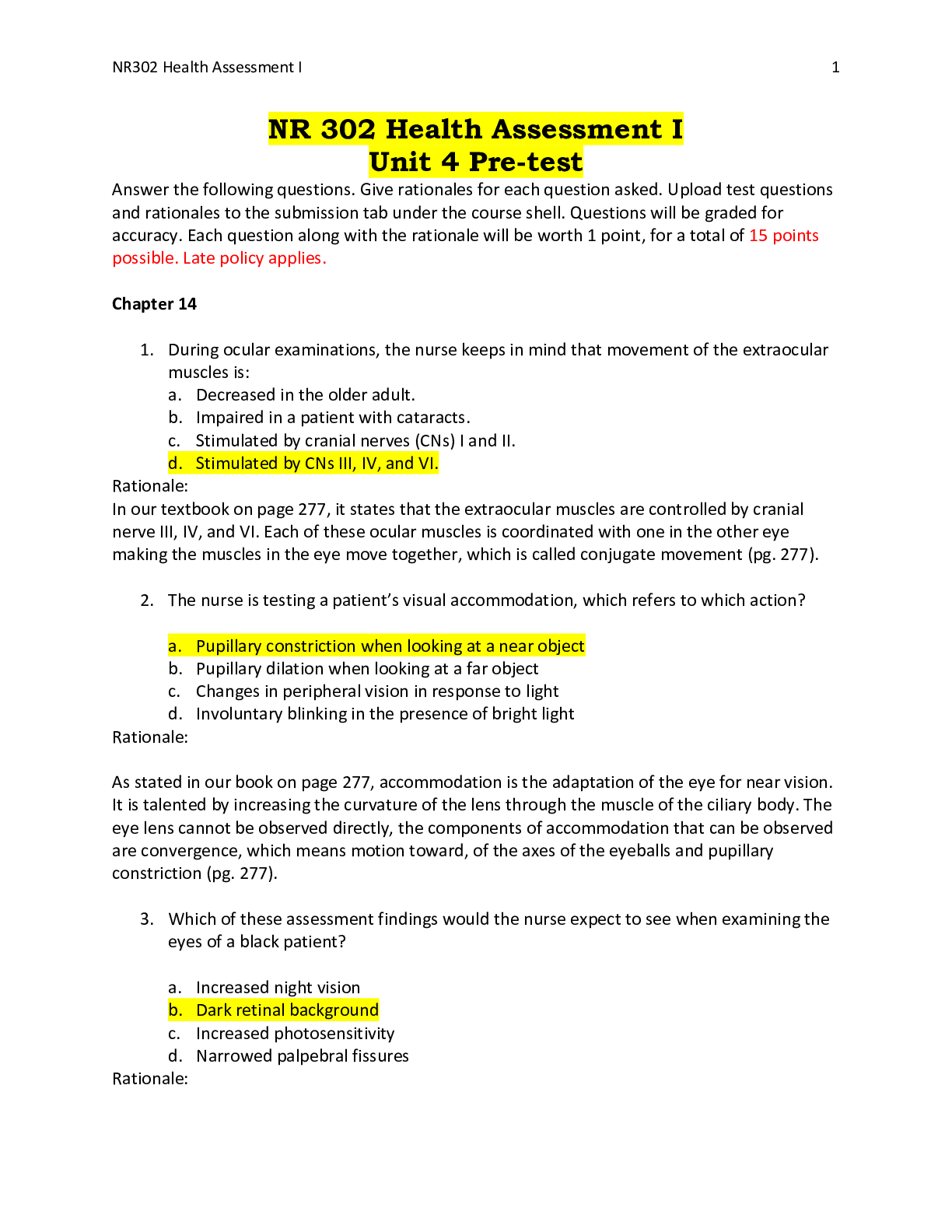
Reviews( 0 )
Document information
Connected school, study & course
About the document
Uploaded On
May 16, 2021
Number of pages
11
Written in
Additional information
This document has been written for:
Uploaded
May 16, 2021
Downloads
0
Views
28

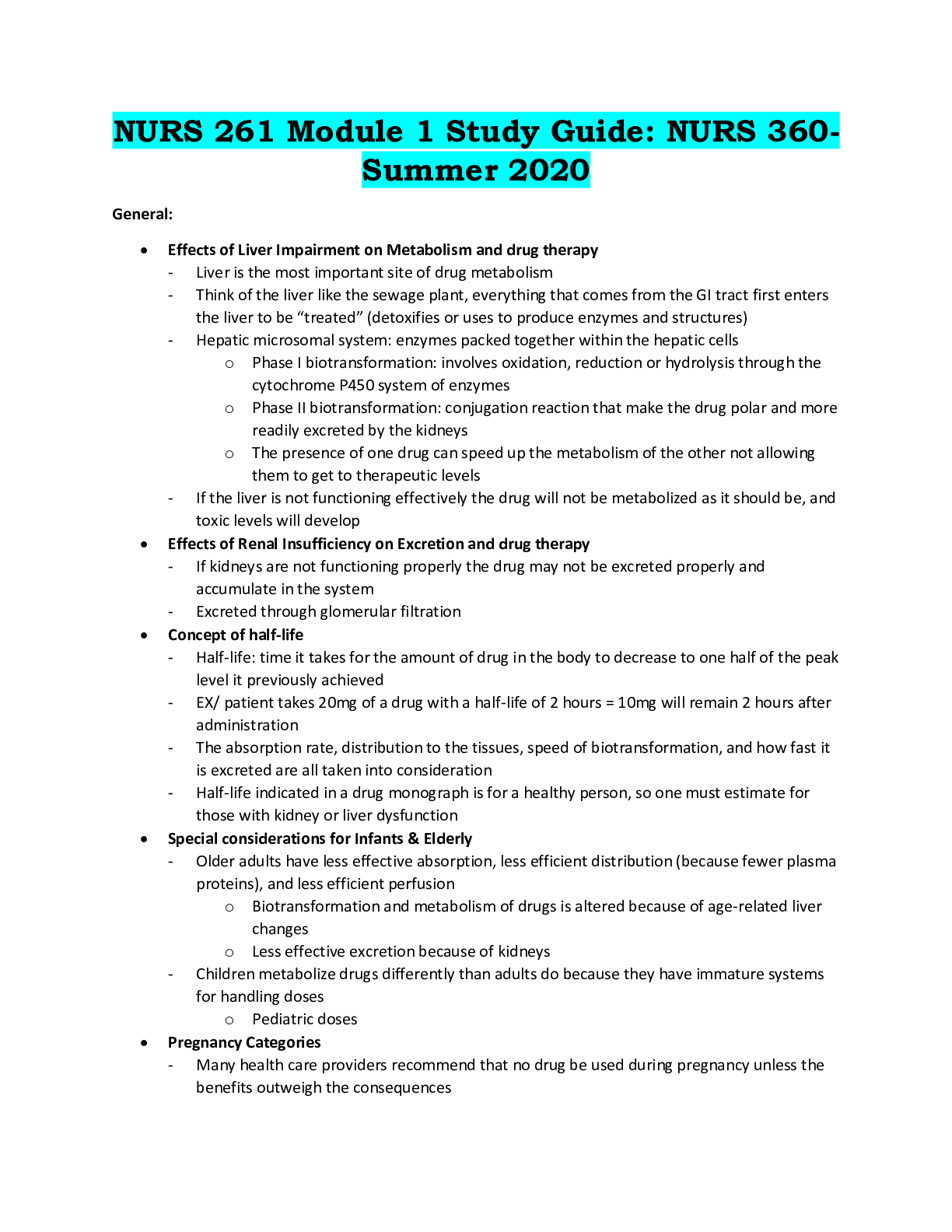
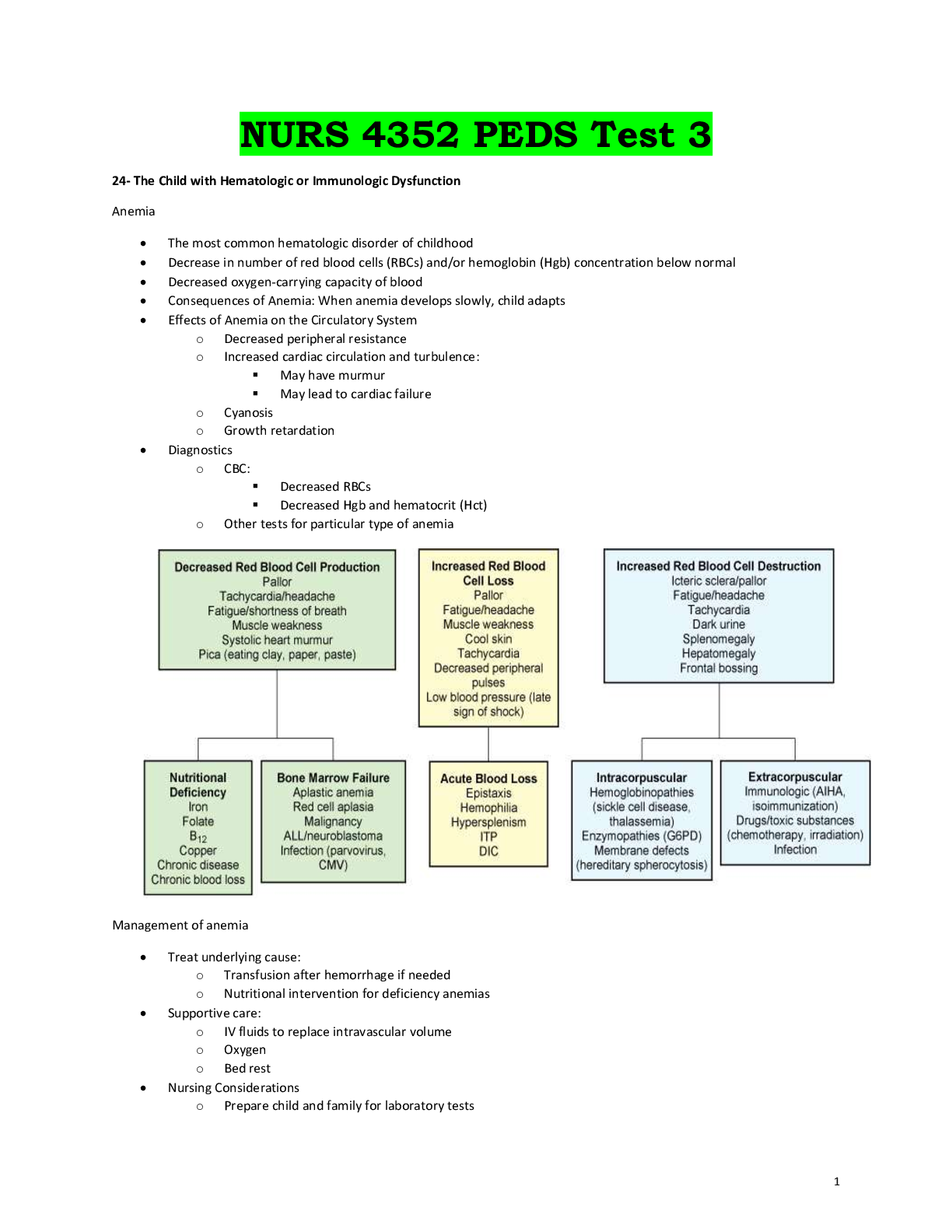
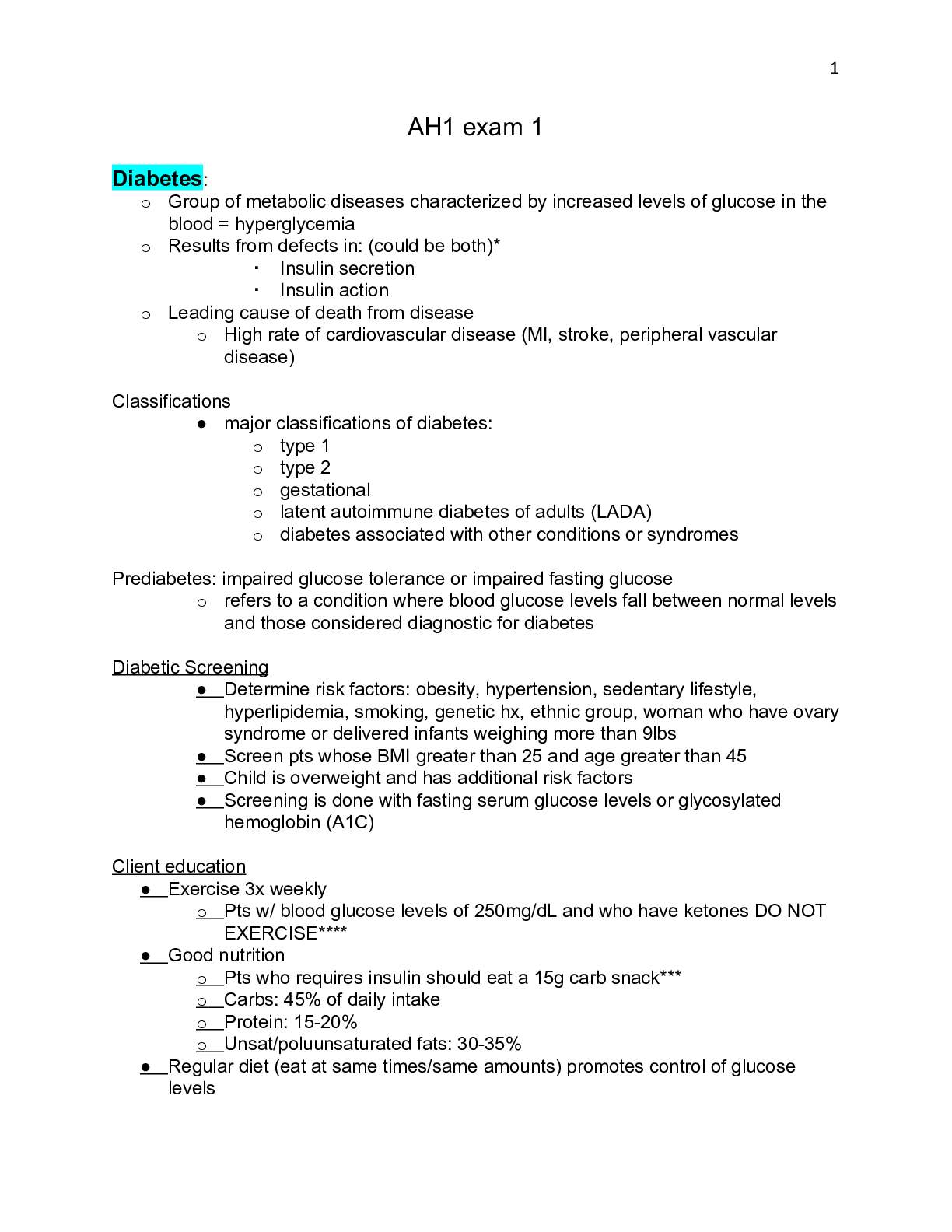
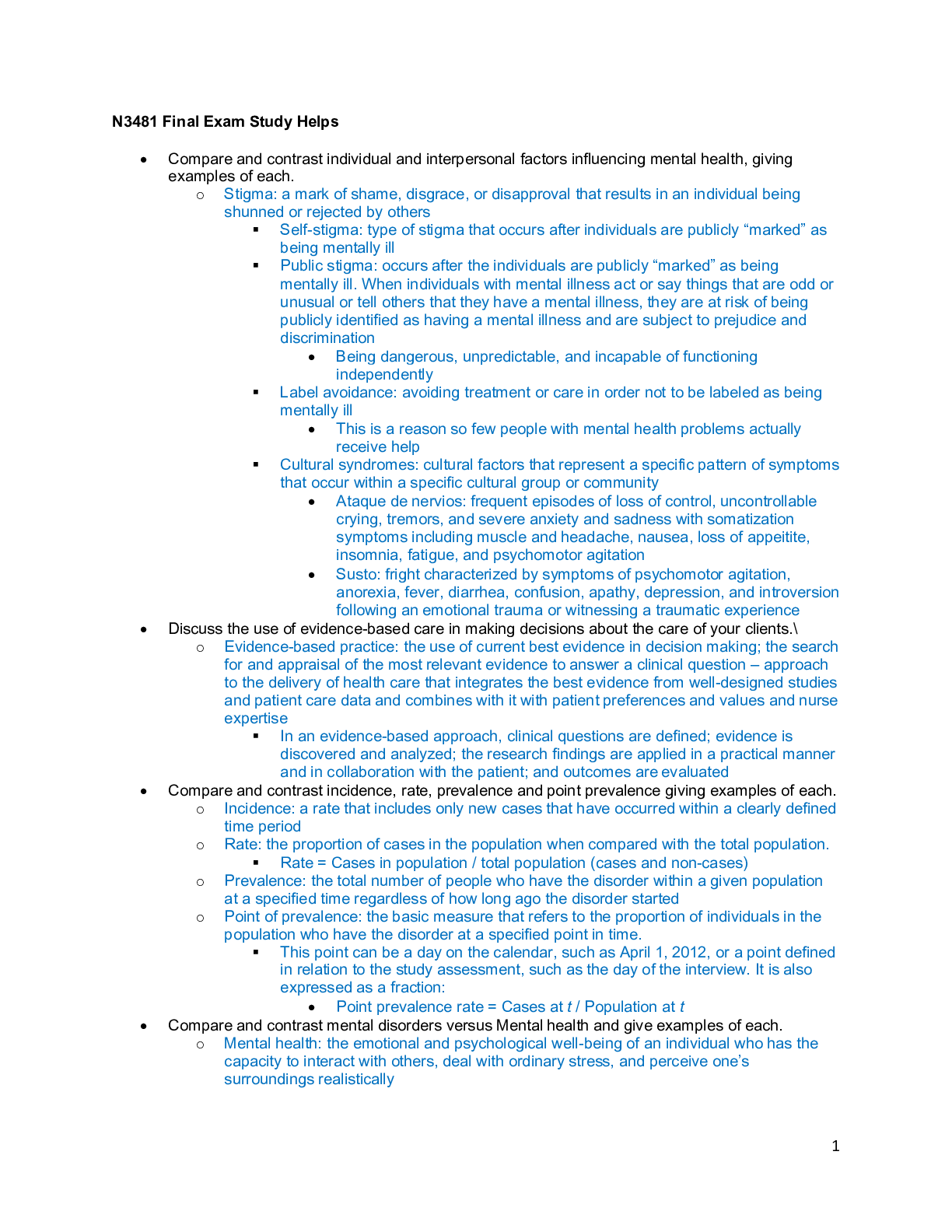
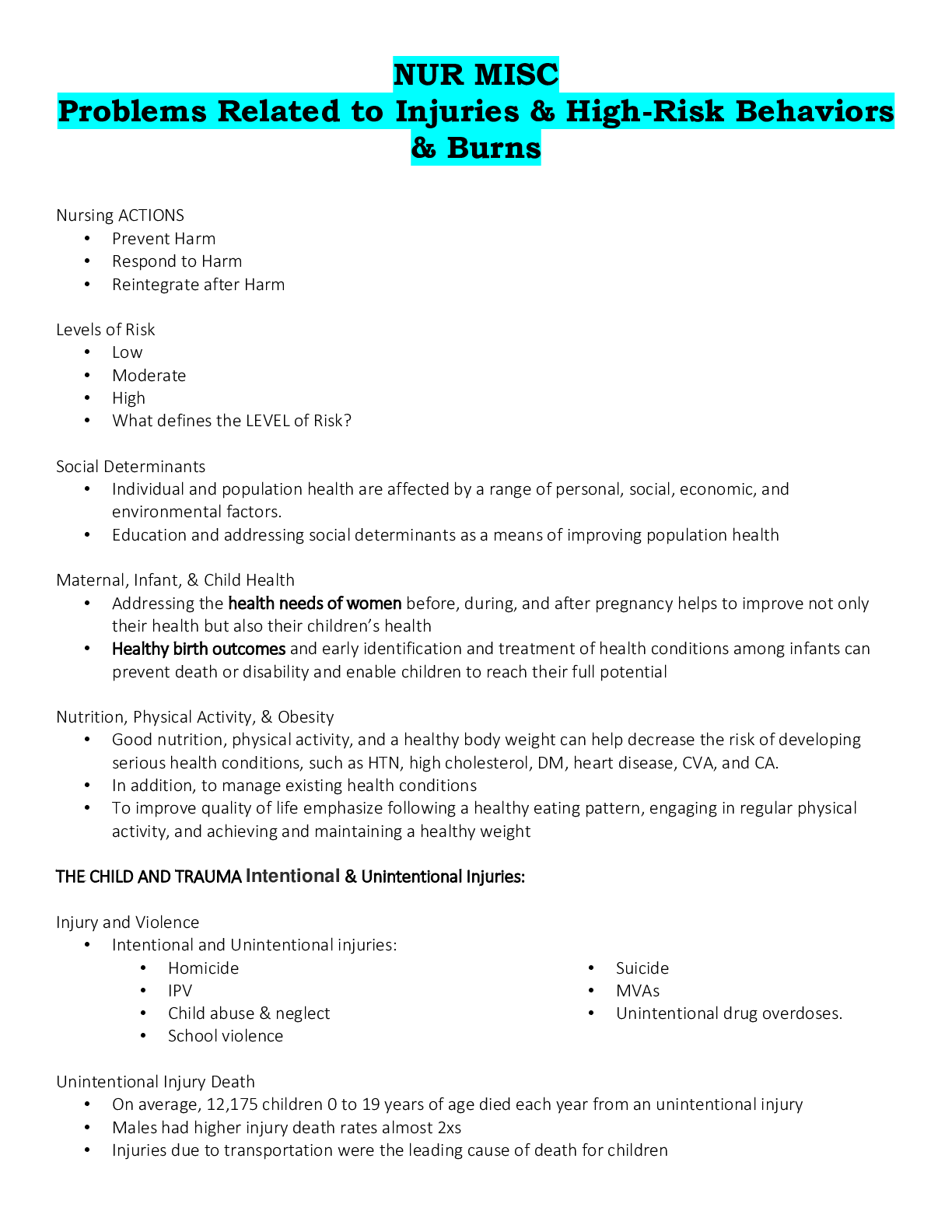
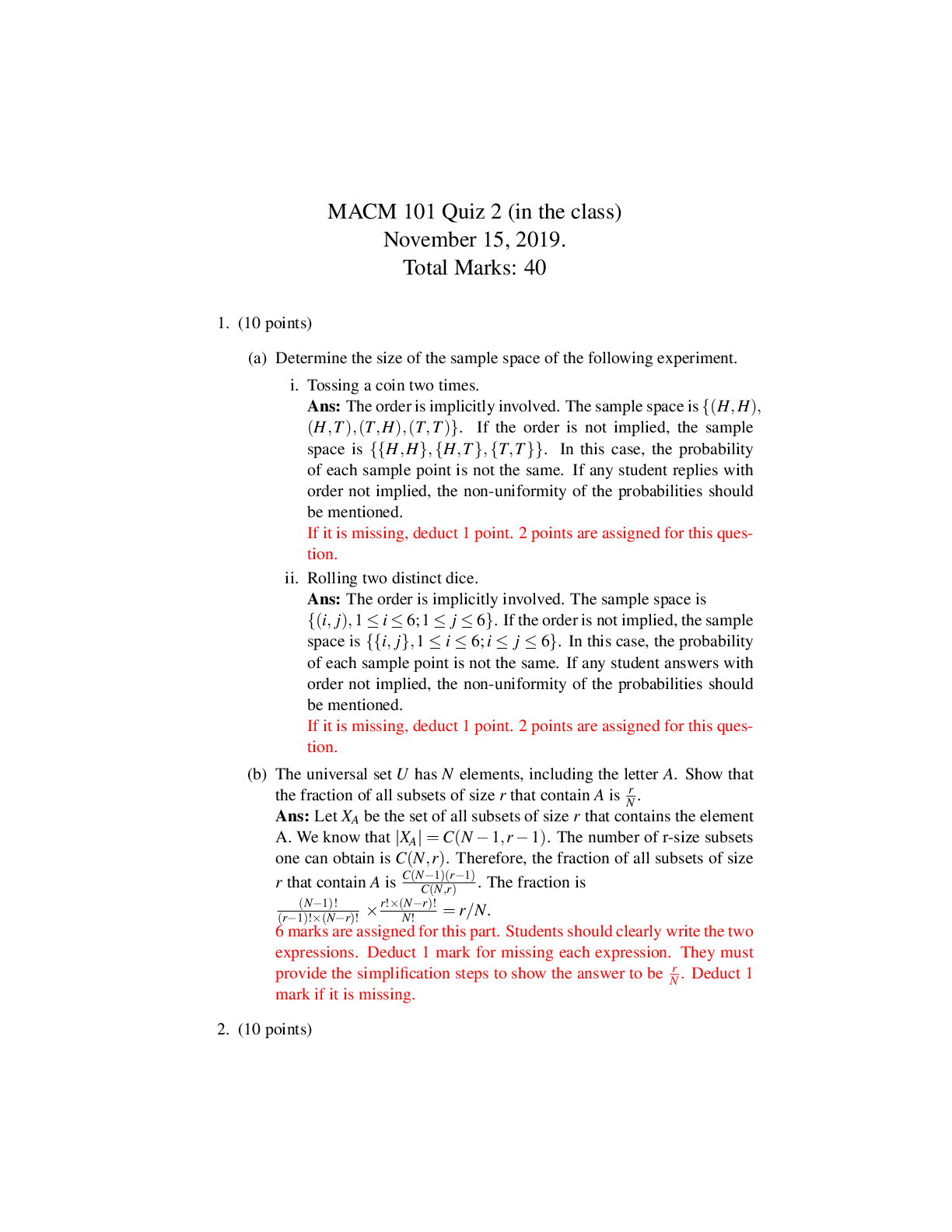
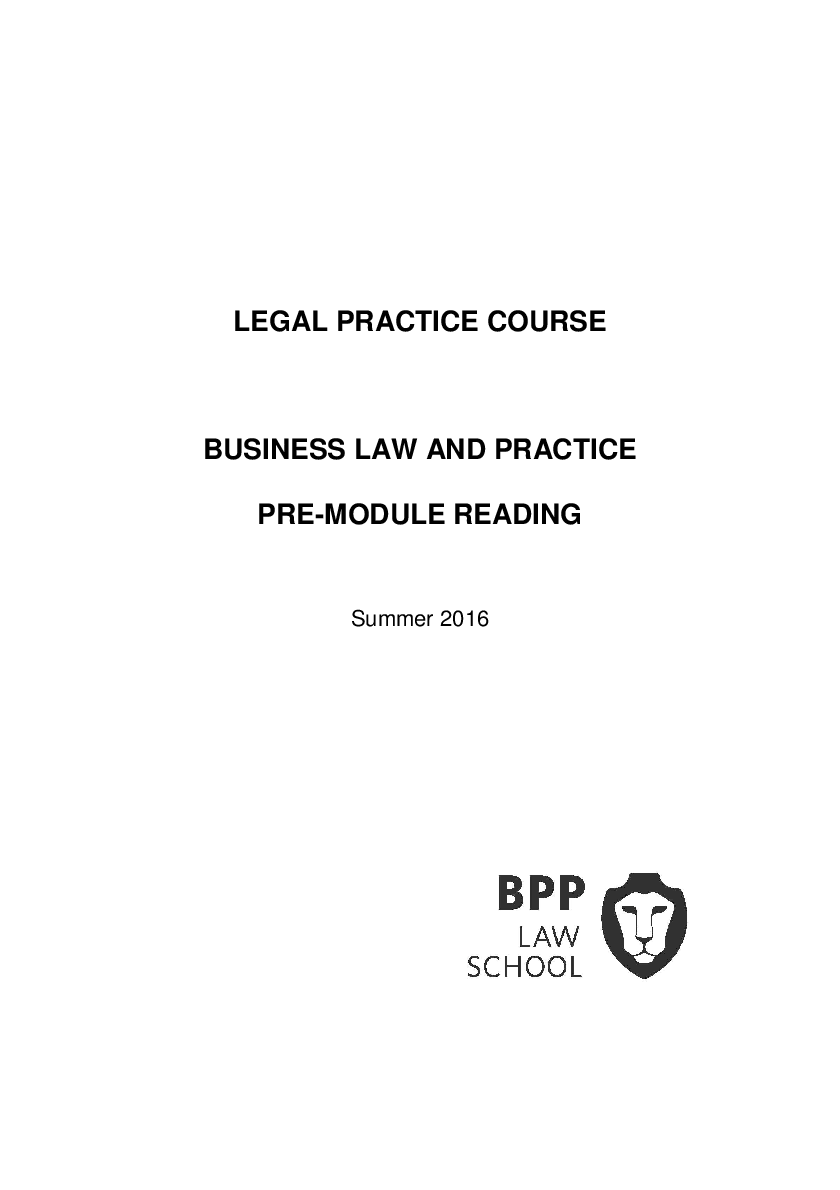
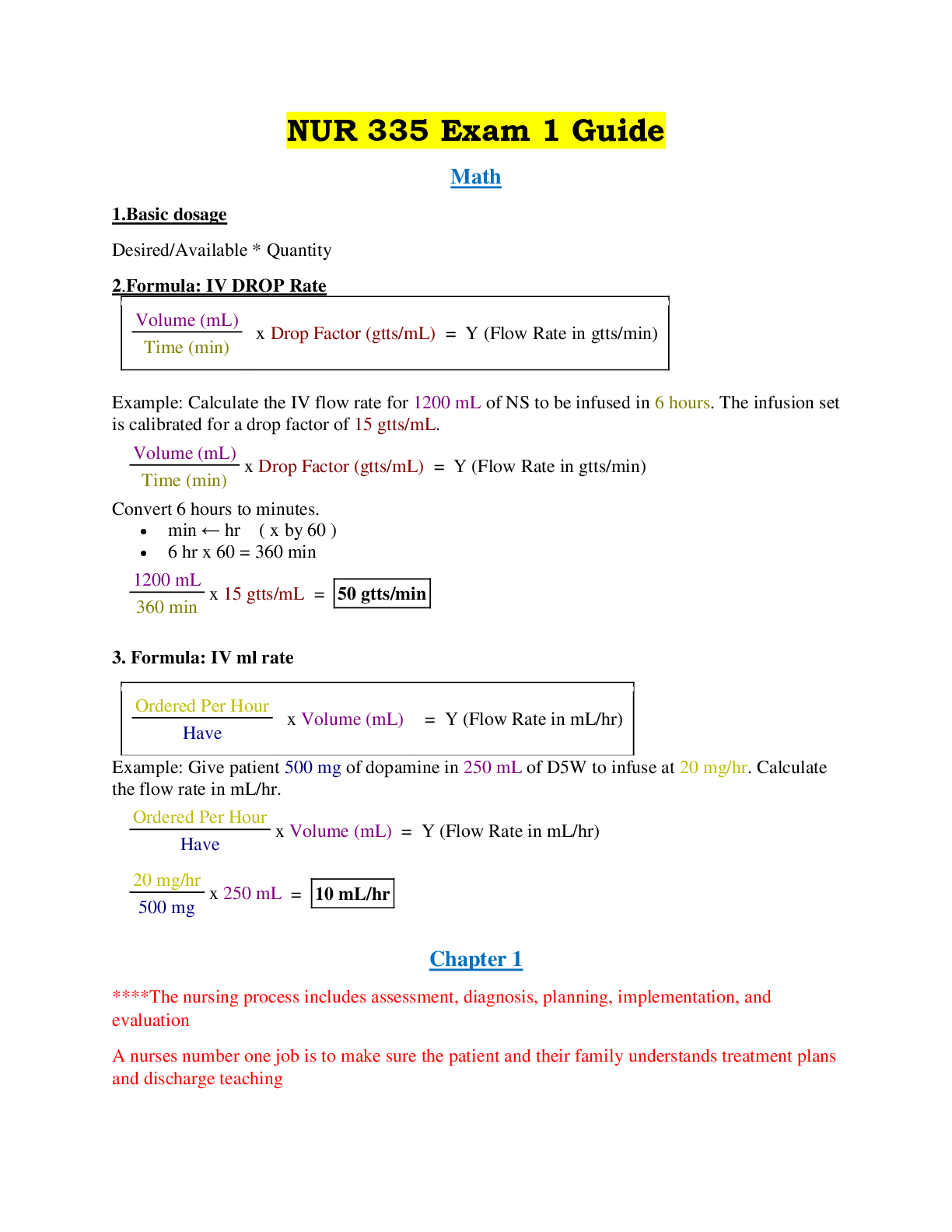

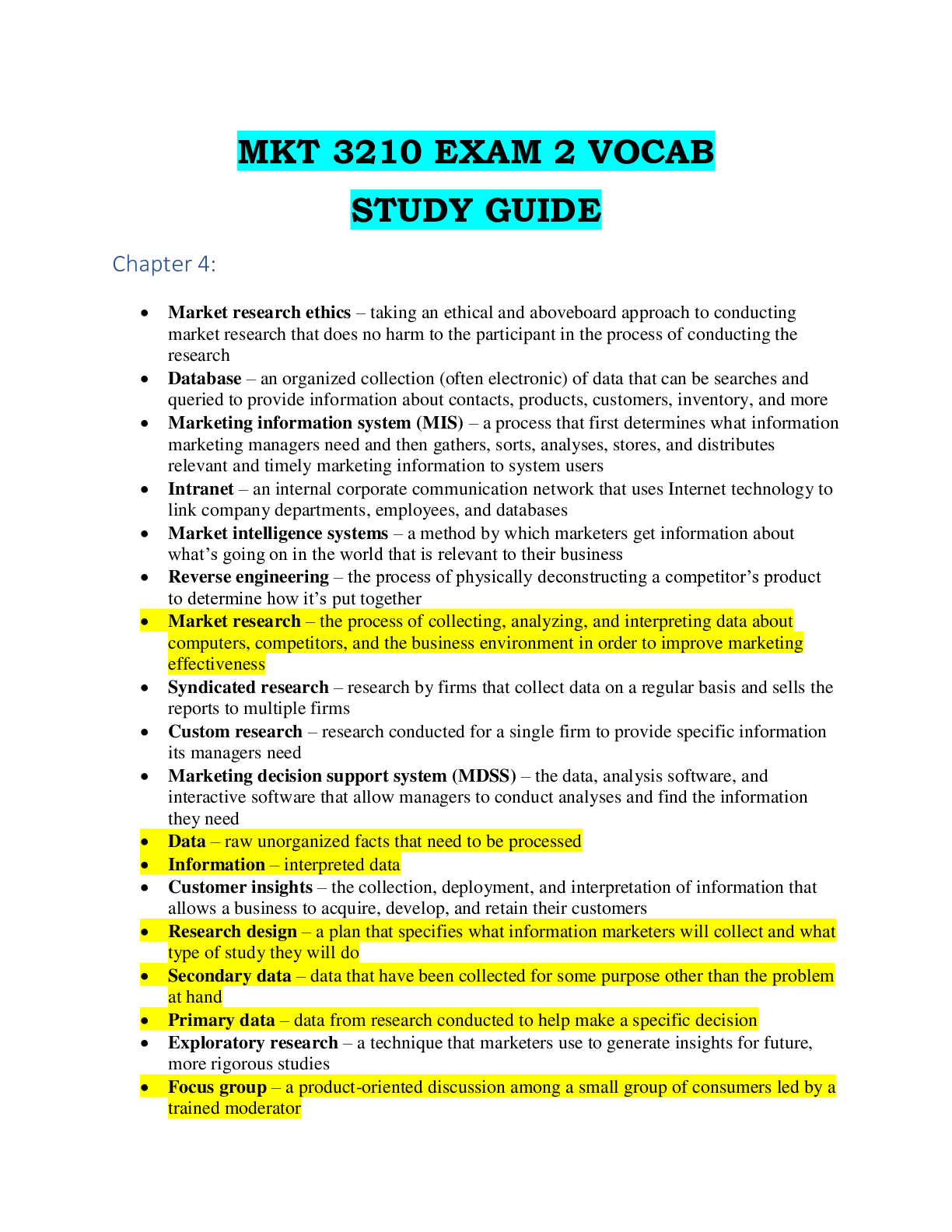
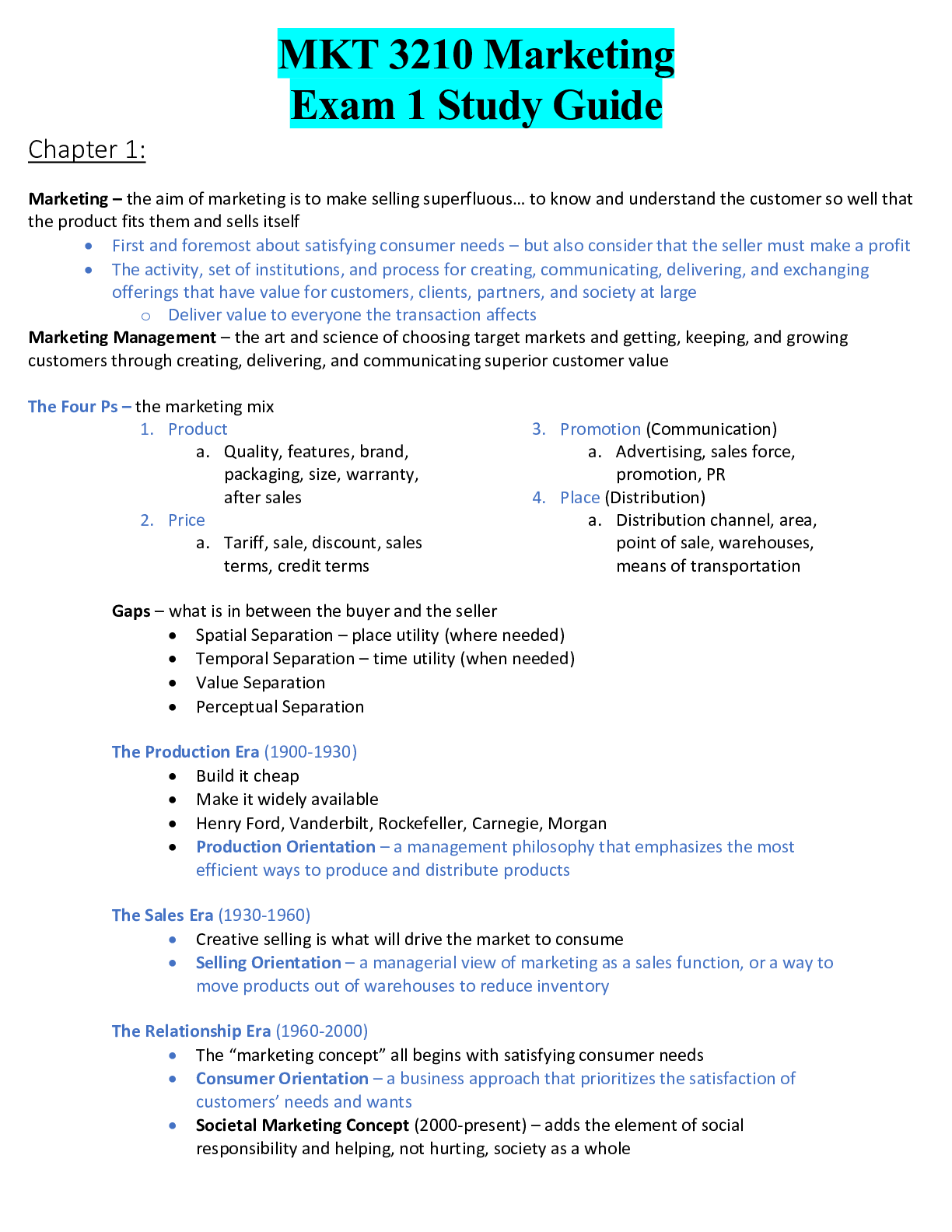
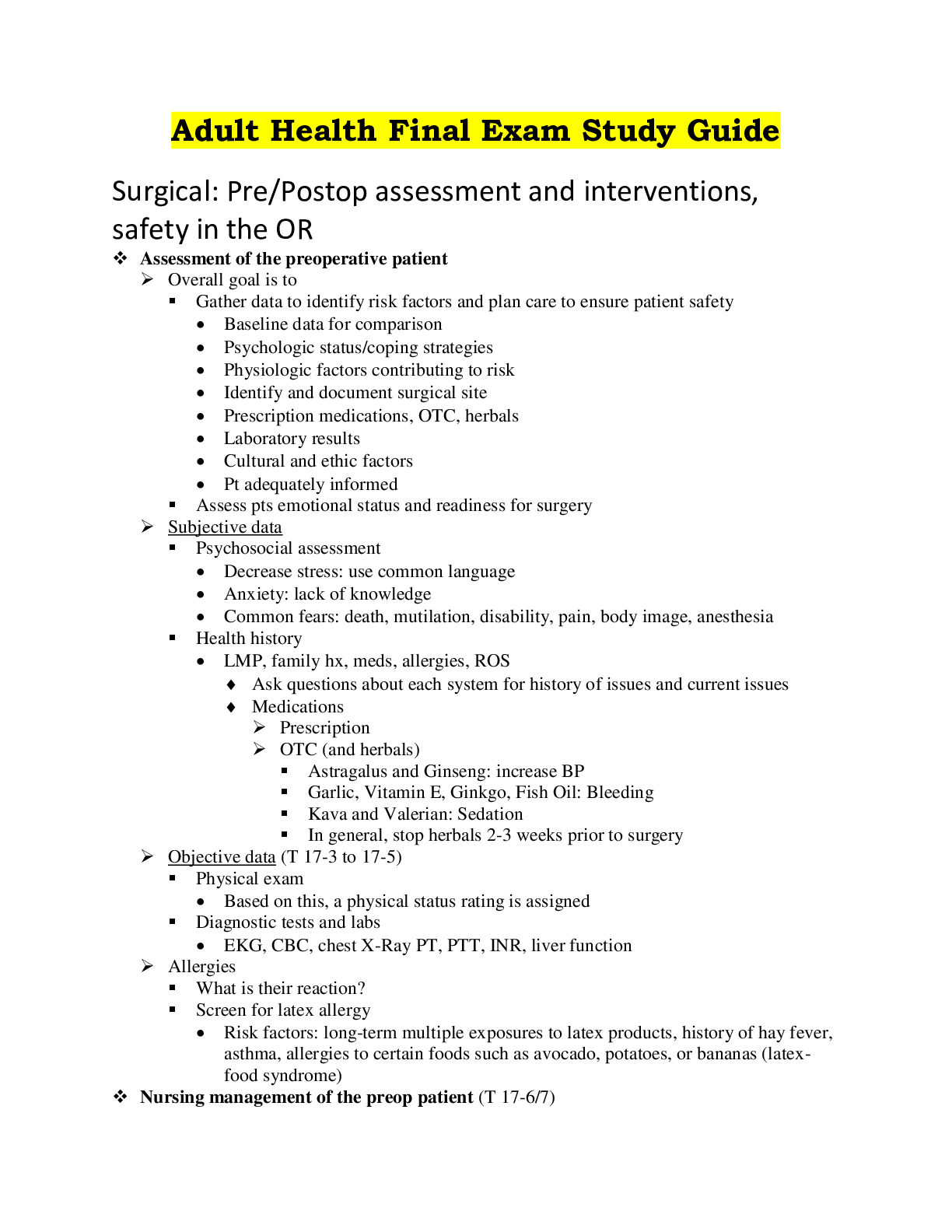
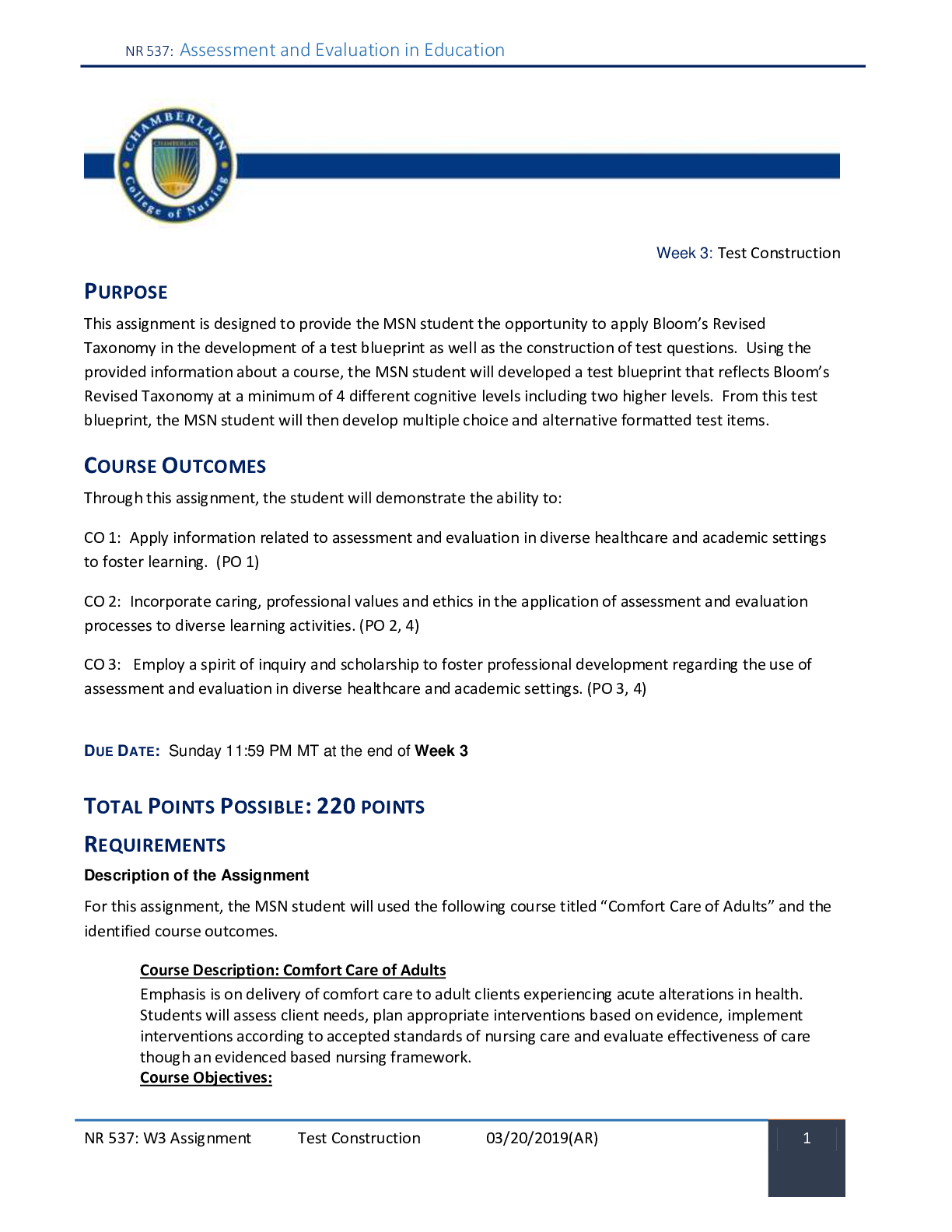

 (4).png)
